Developing and CULTIVATE COLABORATIVE PARTNERSHIPS AND RELATIONSHIPS
VerifiedAdded on 2021/02/20
|18
|5445
|104
AI Summary
INTRODUCTION 1 TASK 11 1. Two areas of legislative and also regulatorycontextincluding involvement. Three techniques used for cultivate relationships which is collaborative as well as partnership.2 4. This Act is used for the students studying in Newton College to increase the collaborative environment by creating better working conditions for the employees. This Act is used for the students studying in Newton College to increase the collaborative environment by creating better working conditions for the employees. Own way of working, communication and also staff supporting of the other
Contribute Materials
Your contribution can guide someone’s learning journey. Share your
documents today.
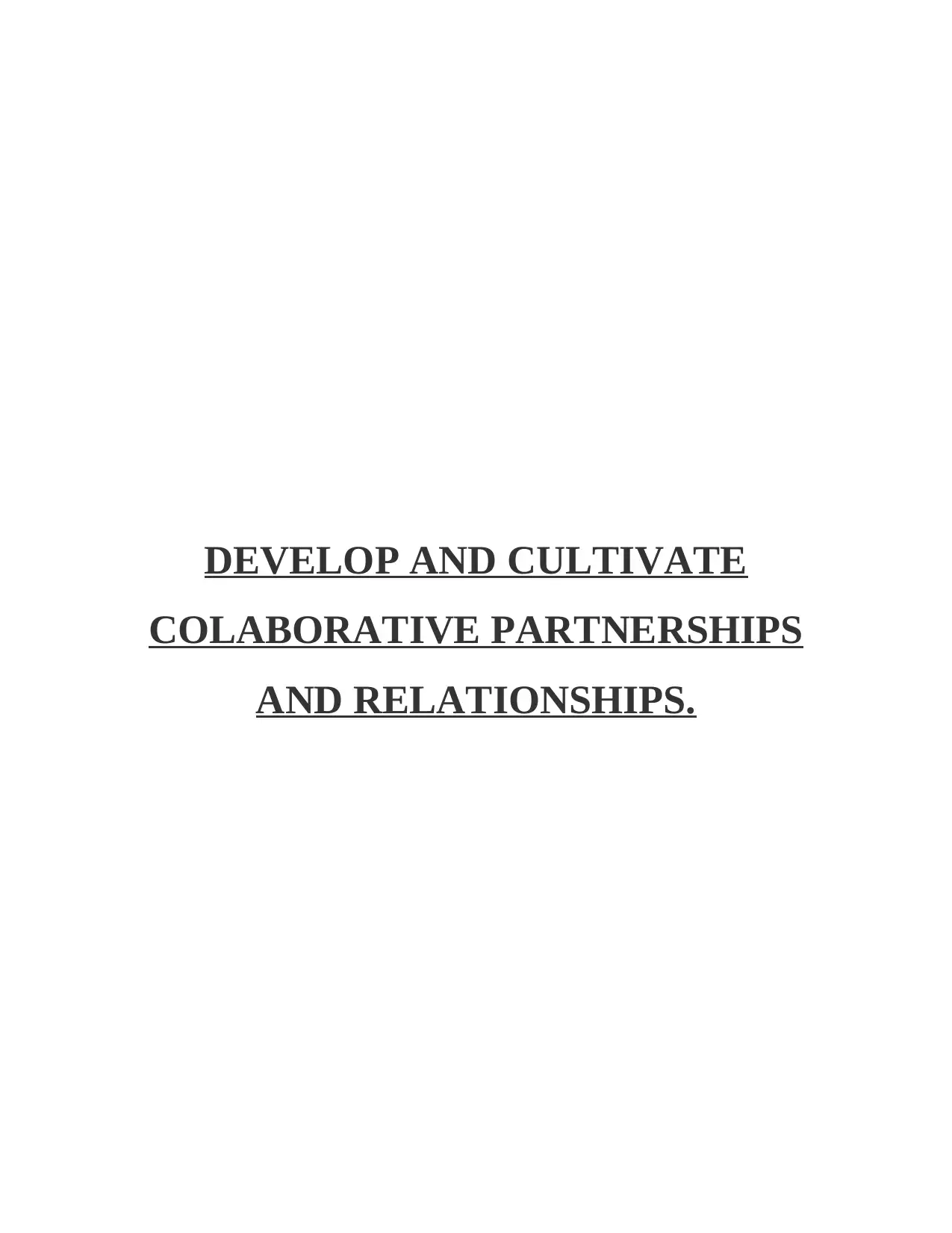
DEVELOP AND CULTIVATE
COLABORATIVE PARTNERSHIPS
AND RELATIONSHIPS.
COLABORATIVE PARTNERSHIPS
AND RELATIONSHIPS.
Secure Best Marks with AI Grader
Need help grading? Try our AI Grader for instant feedback on your assignments.
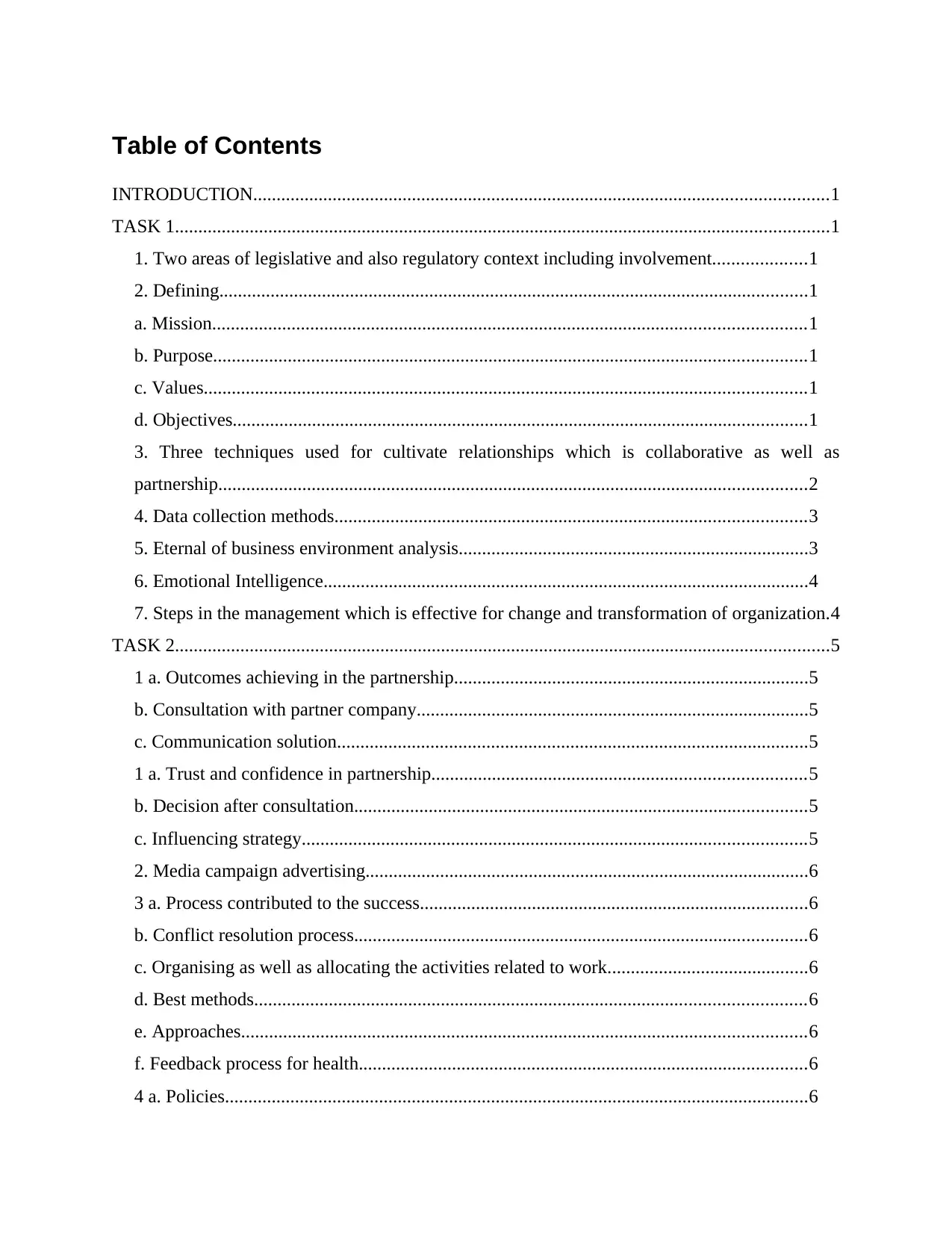
Table of Contents
INTRODUCTION...........................................................................................................................1
TASK 1............................................................................................................................................1
1. Two areas of legislative and also regulatory context including involvement....................1
2. Defining..............................................................................................................................1
a. Mission...............................................................................................................................1
b. Purpose...............................................................................................................................1
c. Values.................................................................................................................................1
d. Objectives...........................................................................................................................1
3. Three techniques used for cultivate relationships which is collaborative as well as
partnership..............................................................................................................................2
4. Data collection methods.....................................................................................................3
5. Eternal of business environment analysis...........................................................................3
6. Emotional Intelligence........................................................................................................4
7. Steps in the management which is effective for change and transformation of organization.4
TASK 2............................................................................................................................................5
1 a. Outcomes achieving in the partnership............................................................................5
b. Consultation with partner company....................................................................................5
c. Communication solution.....................................................................................................5
1 a. Trust and confidence in partnership................................................................................5
b. Decision after consultation.................................................................................................5
c. Influencing strategy............................................................................................................5
2. Media campaign advertising...............................................................................................6
3 a. Process contributed to the success...................................................................................6
b. Conflict resolution process.................................................................................................6
c. Organising as well as allocating the activities related to work...........................................6
d. Best methods......................................................................................................................6
e. Approaches.........................................................................................................................6
f. Feedback process for health................................................................................................6
4 a. Policies.............................................................................................................................6
INTRODUCTION...........................................................................................................................1
TASK 1............................................................................................................................................1
1. Two areas of legislative and also regulatory context including involvement....................1
2. Defining..............................................................................................................................1
a. Mission...............................................................................................................................1
b. Purpose...............................................................................................................................1
c. Values.................................................................................................................................1
d. Objectives...........................................................................................................................1
3. Three techniques used for cultivate relationships which is collaborative as well as
partnership..............................................................................................................................2
4. Data collection methods.....................................................................................................3
5. Eternal of business environment analysis...........................................................................3
6. Emotional Intelligence........................................................................................................4
7. Steps in the management which is effective for change and transformation of organization.4
TASK 2............................................................................................................................................5
1 a. Outcomes achieving in the partnership............................................................................5
b. Consultation with partner company....................................................................................5
c. Communication solution.....................................................................................................5
1 a. Trust and confidence in partnership................................................................................5
b. Decision after consultation.................................................................................................5
c. Influencing strategy............................................................................................................5
2. Media campaign advertising...............................................................................................6
3 a. Process contributed to the success...................................................................................6
b. Conflict resolution process.................................................................................................6
c. Organising as well as allocating the activities related to work...........................................6
d. Best methods......................................................................................................................6
e. Approaches.........................................................................................................................6
f. Feedback process for health................................................................................................6
4 a. Policies.............................................................................................................................6
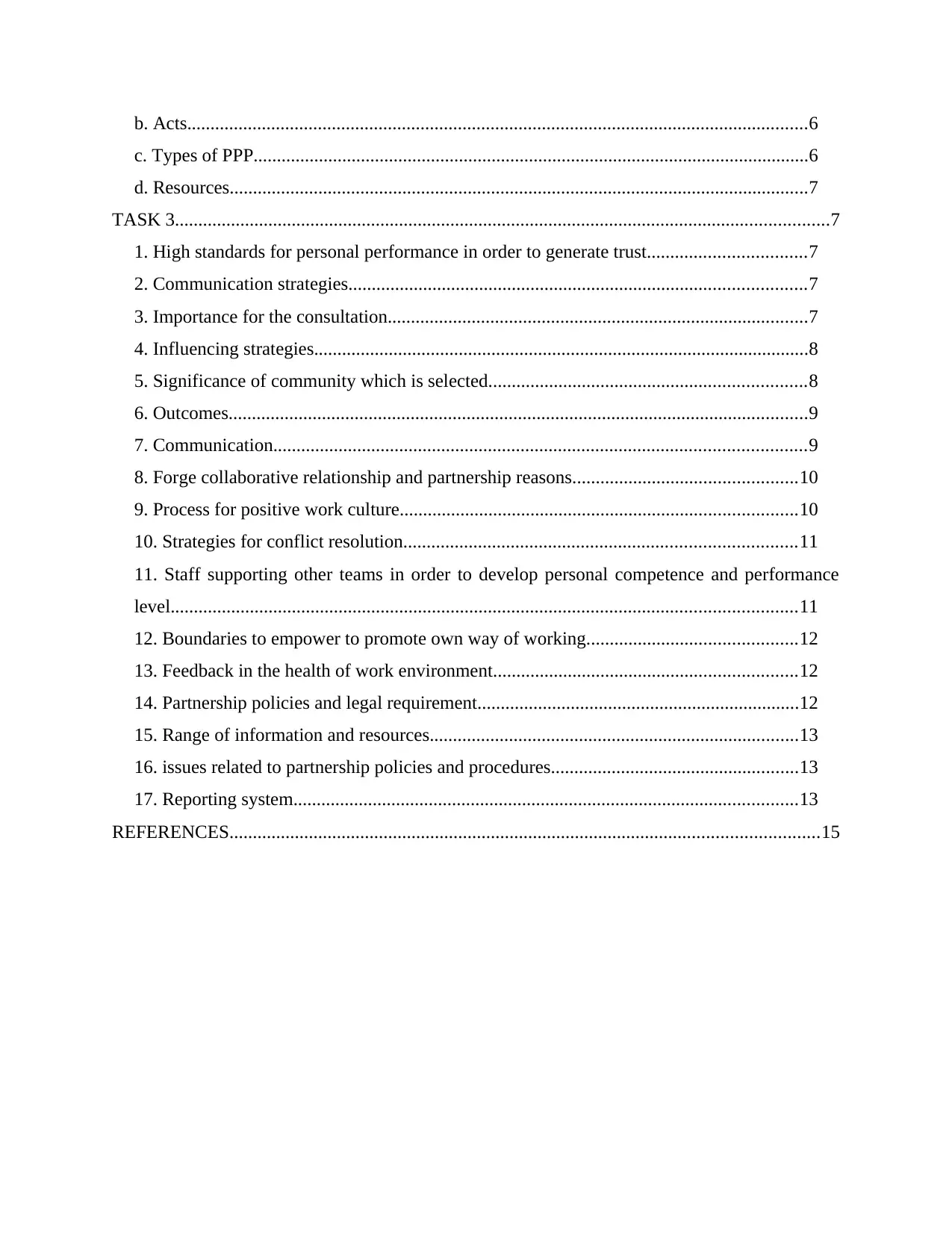
b. Acts.....................................................................................................................................6
c. Types of PPP.......................................................................................................................6
d. Resources............................................................................................................................7
TASK 3............................................................................................................................................7
1. High standards for personal performance in order to generate trust..................................7
2. Communication strategies..................................................................................................7
3. Importance for the consultation..........................................................................................7
4. Influencing strategies..........................................................................................................8
5. Significance of community which is selected....................................................................8
6. Outcomes............................................................................................................................9
7. Communication..................................................................................................................9
8. Forge collaborative relationship and partnership reasons................................................10
9. Process for positive work culture.....................................................................................10
10. Strategies for conflict resolution....................................................................................11
11. Staff supporting other teams in order to develop personal competence and performance
level......................................................................................................................................11
12. Boundaries to empower to promote own way of working.............................................12
13. Feedback in the health of work environment.................................................................12
14. Partnership policies and legal requirement.....................................................................12
15. Range of information and resources...............................................................................13
16. issues related to partnership policies and procedures.....................................................13
17. Reporting system............................................................................................................13
REFERENCES..............................................................................................................................15
c. Types of PPP.......................................................................................................................6
d. Resources............................................................................................................................7
TASK 3............................................................................................................................................7
1. High standards for personal performance in order to generate trust..................................7
2. Communication strategies..................................................................................................7
3. Importance for the consultation..........................................................................................7
4. Influencing strategies..........................................................................................................8
5. Significance of community which is selected....................................................................8
6. Outcomes............................................................................................................................9
7. Communication..................................................................................................................9
8. Forge collaborative relationship and partnership reasons................................................10
9. Process for positive work culture.....................................................................................10
10. Strategies for conflict resolution....................................................................................11
11. Staff supporting other teams in order to develop personal competence and performance
level......................................................................................................................................11
12. Boundaries to empower to promote own way of working.............................................12
13. Feedback in the health of work environment.................................................................12
14. Partnership policies and legal requirement.....................................................................12
15. Range of information and resources...............................................................................13
16. issues related to partnership policies and procedures.....................................................13
17. Reporting system............................................................................................................13
REFERENCES..............................................................................................................................15
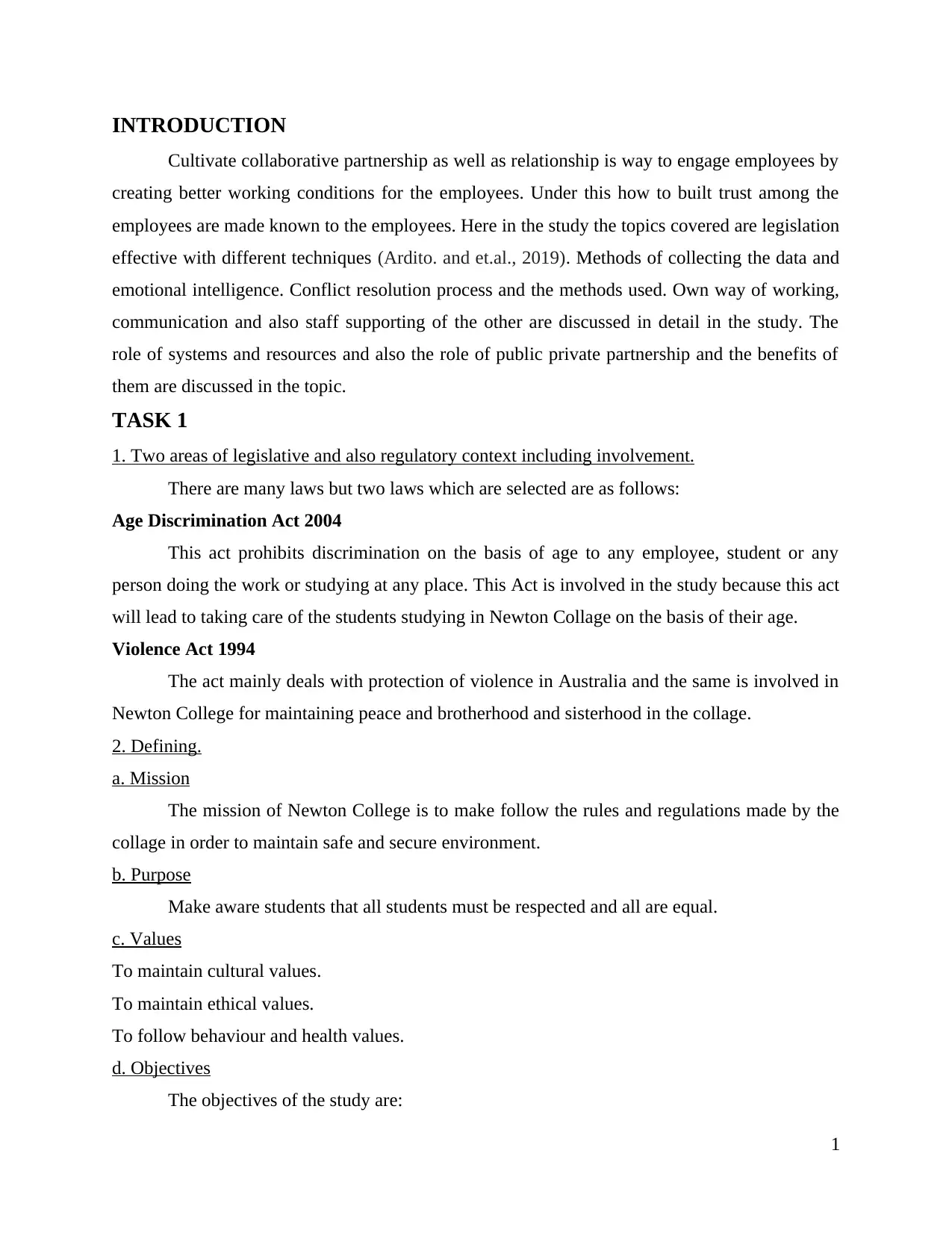
INTRODUCTION
Cultivate collaborative partnership as well as relationship is way to engage employees by
creating better working conditions for the employees. Under this how to built trust among the
employees are made known to the employees. Here in the study the topics covered are legislation
effective with different techniques (Ardito. and et.al., 2019). Methods of collecting the data and
emotional intelligence. Conflict resolution process and the methods used. Own way of working,
communication and also staff supporting of the other are discussed in detail in the study. The
role of systems and resources and also the role of public private partnership and the benefits of
them are discussed in the topic.
TASK 1
1. Two areas of legislative and also regulatory context including involvement.
There are many laws but two laws which are selected are as follows:
Age Discrimination Act 2004
This act prohibits discrimination on the basis of age to any employee, student or any
person doing the work or studying at any place. This Act is involved in the study because this act
will lead to taking care of the students studying in Newton Collage on the basis of their age.
Violence Act 1994
The act mainly deals with protection of violence in Australia and the same is involved in
Newton College for maintaining peace and brotherhood and sisterhood in the collage.
2. Defining.
a. Mission
The mission of Newton College is to make follow the rules and regulations made by the
collage in order to maintain safe and secure environment.
b. Purpose
Make aware students that all students must be respected and all are equal.
c. Values
To maintain cultural values.
To maintain ethical values.
To follow behaviour and health values.
d. Objectives
The objectives of the study are:
1
Cultivate collaborative partnership as well as relationship is way to engage employees by
creating better working conditions for the employees. Under this how to built trust among the
employees are made known to the employees. Here in the study the topics covered are legislation
effective with different techniques (Ardito. and et.al., 2019). Methods of collecting the data and
emotional intelligence. Conflict resolution process and the methods used. Own way of working,
communication and also staff supporting of the other are discussed in detail in the study. The
role of systems and resources and also the role of public private partnership and the benefits of
them are discussed in the topic.
TASK 1
1. Two areas of legislative and also regulatory context including involvement.
There are many laws but two laws which are selected are as follows:
Age Discrimination Act 2004
This act prohibits discrimination on the basis of age to any employee, student or any
person doing the work or studying at any place. This Act is involved in the study because this act
will lead to taking care of the students studying in Newton Collage on the basis of their age.
Violence Act 1994
The act mainly deals with protection of violence in Australia and the same is involved in
Newton College for maintaining peace and brotherhood and sisterhood in the collage.
2. Defining.
a. Mission
The mission of Newton College is to make follow the rules and regulations made by the
collage in order to maintain safe and secure environment.
b. Purpose
Make aware students that all students must be respected and all are equal.
c. Values
To maintain cultural values.
To maintain ethical values.
To follow behaviour and health values.
d. Objectives
The objectives of the study are:
1
Secure Best Marks with AI Grader
Need help grading? Try our AI Grader for instant feedback on your assignments.
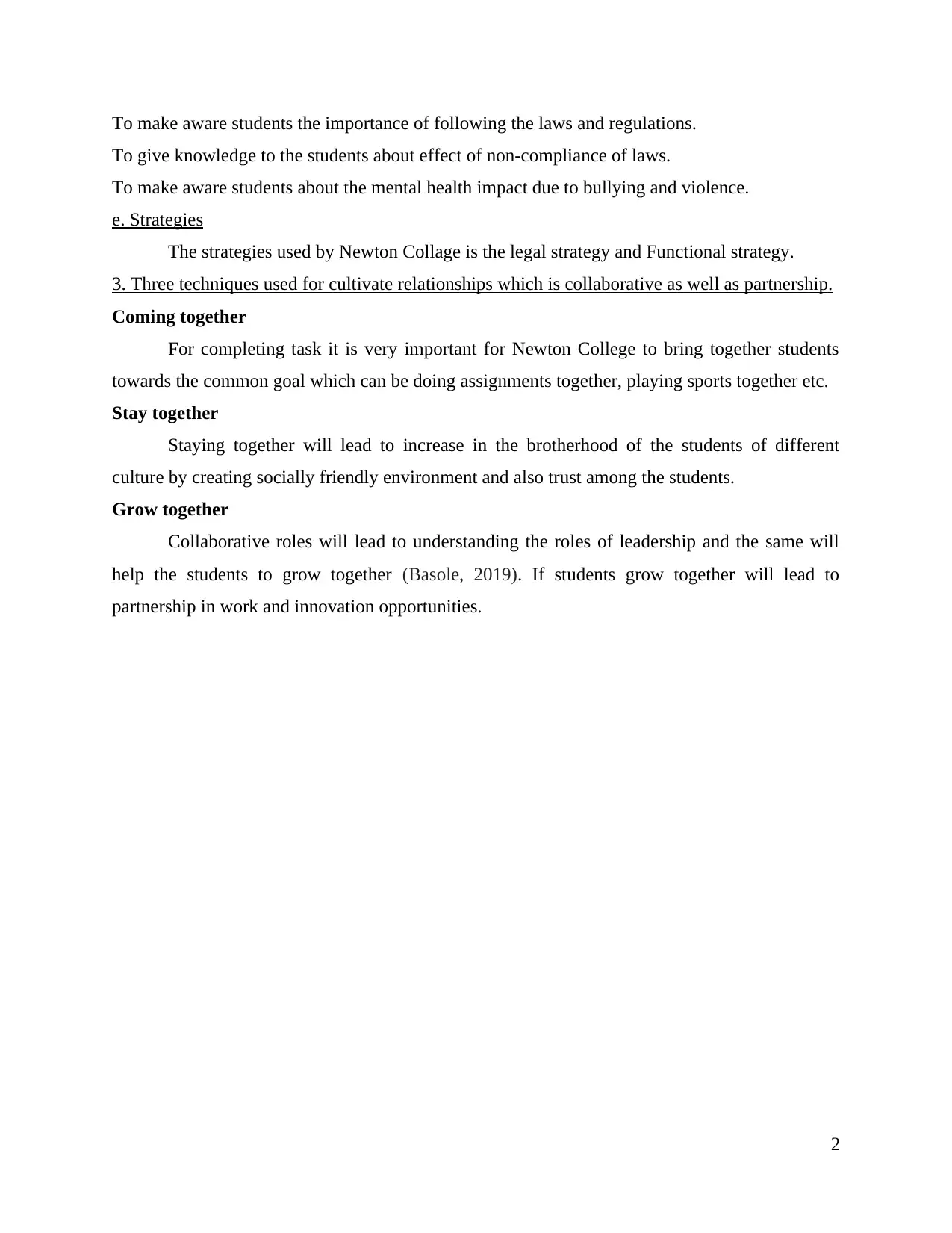
To make aware students the importance of following the laws and regulations.
To give knowledge to the students about effect of non-compliance of laws.
To make aware students about the mental health impact due to bullying and violence.
e. Strategies
The strategies used by Newton Collage is the legal strategy and Functional strategy.
3. Three techniques used for cultivate relationships which is collaborative as well as partnership.
Coming together
For completing task it is very important for Newton College to bring together students
towards the common goal which can be doing assignments together, playing sports together etc.
Stay together
Staying together will lead to increase in the brotherhood of the students of different
culture by creating socially friendly environment and also trust among the students.
Grow together
Collaborative roles will lead to understanding the roles of leadership and the same will
help the students to grow together (Basole, 2019). If students grow together will lead to
partnership in work and innovation opportunities.
2
To give knowledge to the students about effect of non-compliance of laws.
To make aware students about the mental health impact due to bullying and violence.
e. Strategies
The strategies used by Newton Collage is the legal strategy and Functional strategy.
3. Three techniques used for cultivate relationships which is collaborative as well as partnership.
Coming together
For completing task it is very important for Newton College to bring together students
towards the common goal which can be doing assignments together, playing sports together etc.
Stay together
Staying together will lead to increase in the brotherhood of the students of different
culture by creating socially friendly environment and also trust among the students.
Grow together
Collaborative roles will lead to understanding the roles of leadership and the same will
help the students to grow together (Basole, 2019). If students grow together will lead to
partnership in work and innovation opportunities.
2
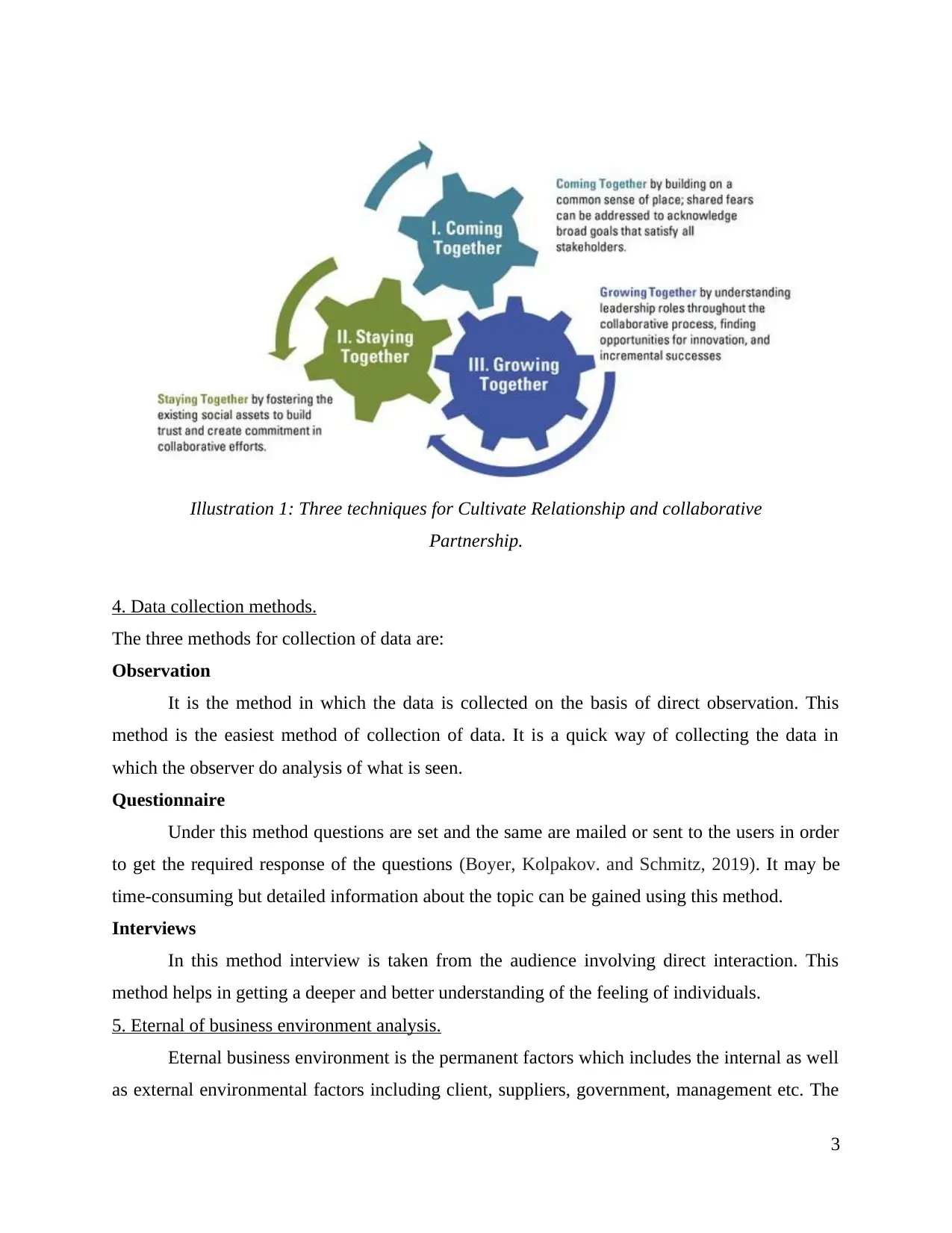
4. Data collection methods.
The three methods for collection of data are:
Observation
It is the method in which the data is collected on the basis of direct observation. This
method is the easiest method of collection of data. It is a quick way of collecting the data in
which the observer do analysis of what is seen.
Questionnaire
Under this method questions are set and the same are mailed or sent to the users in order
to get the required response of the questions (Boyer, Kolpakov. and Schmitz, 2019). It may be
time-consuming but detailed information about the topic can be gained using this method.
Interviews
In this method interview is taken from the audience involving direct interaction. This
method helps in getting a deeper and better understanding of the feeling of individuals.
5. Eternal of business environment analysis.
Eternal business environment is the permanent factors which includes the internal as well
as external environmental factors including client, suppliers, government, management etc. The
3
Illustration 1: Three techniques for Cultivate Relationship and collaborative
Partnership.
The three methods for collection of data are:
Observation
It is the method in which the data is collected on the basis of direct observation. This
method is the easiest method of collection of data. It is a quick way of collecting the data in
which the observer do analysis of what is seen.
Questionnaire
Under this method questions are set and the same are mailed or sent to the users in order
to get the required response of the questions (Boyer, Kolpakov. and Schmitz, 2019). It may be
time-consuming but detailed information about the topic can be gained using this method.
Interviews
In this method interview is taken from the audience involving direct interaction. This
method helps in getting a deeper and better understanding of the feeling of individuals.
5. Eternal of business environment analysis.
Eternal business environment is the permanent factors which includes the internal as well
as external environmental factors including client, suppliers, government, management etc. The
3
Illustration 1: Three techniques for Cultivate Relationship and collaborative
Partnership.
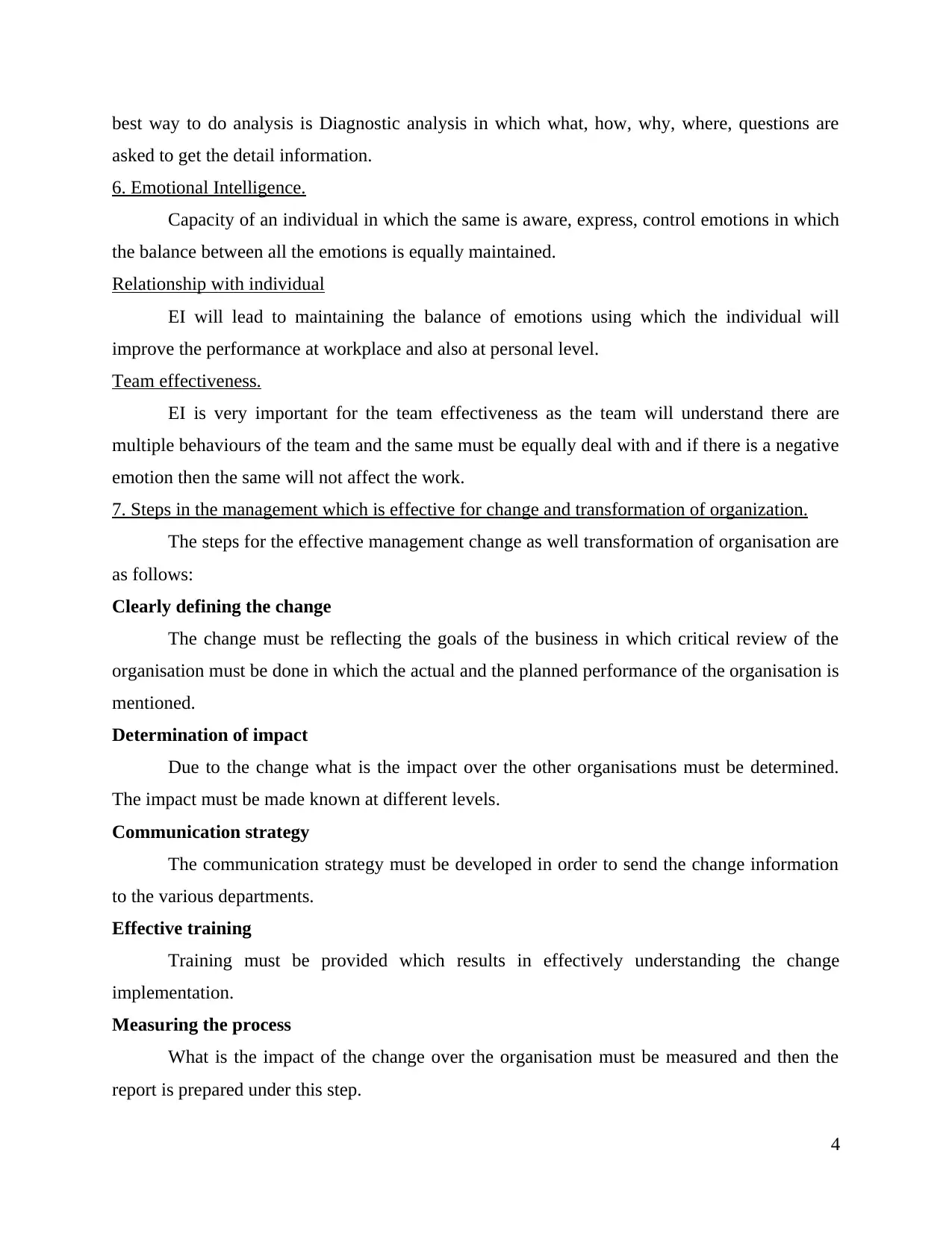
best way to do analysis is Diagnostic analysis in which what, how, why, where, questions are
asked to get the detail information.
6. Emotional Intelligence.
Capacity of an individual in which the same is aware, express, control emotions in which
the balance between all the emotions is equally maintained.
Relationship with individual
EI will lead to maintaining the balance of emotions using which the individual will
improve the performance at workplace and also at personal level.
Team effectiveness.
EI is very important for the team effectiveness as the team will understand there are
multiple behaviours of the team and the same must be equally deal with and if there is a negative
emotion then the same will not affect the work.
7. Steps in the management which is effective for change and transformation of organization.
The steps for the effective management change as well transformation of organisation are
as follows:
Clearly defining the change
The change must be reflecting the goals of the business in which critical review of the
organisation must be done in which the actual and the planned performance of the organisation is
mentioned.
Determination of impact
Due to the change what is the impact over the other organisations must be determined.
The impact must be made known at different levels.
Communication strategy
The communication strategy must be developed in order to send the change information
to the various departments.
Effective training
Training must be provided which results in effectively understanding the change
implementation.
Measuring the process
What is the impact of the change over the organisation must be measured and then the
report is prepared under this step.
4
asked to get the detail information.
6. Emotional Intelligence.
Capacity of an individual in which the same is aware, express, control emotions in which
the balance between all the emotions is equally maintained.
Relationship with individual
EI will lead to maintaining the balance of emotions using which the individual will
improve the performance at workplace and also at personal level.
Team effectiveness.
EI is very important for the team effectiveness as the team will understand there are
multiple behaviours of the team and the same must be equally deal with and if there is a negative
emotion then the same will not affect the work.
7. Steps in the management which is effective for change and transformation of organization.
The steps for the effective management change as well transformation of organisation are
as follows:
Clearly defining the change
The change must be reflecting the goals of the business in which critical review of the
organisation must be done in which the actual and the planned performance of the organisation is
mentioned.
Determination of impact
Due to the change what is the impact over the other organisations must be determined.
The impact must be made known at different levels.
Communication strategy
The communication strategy must be developed in order to send the change information
to the various departments.
Effective training
Training must be provided which results in effectively understanding the change
implementation.
Measuring the process
What is the impact of the change over the organisation must be measured and then the
report is prepared under this step.
4
Paraphrase This Document
Need a fresh take? Get an instant paraphrase of this document with our AI Paraphraser
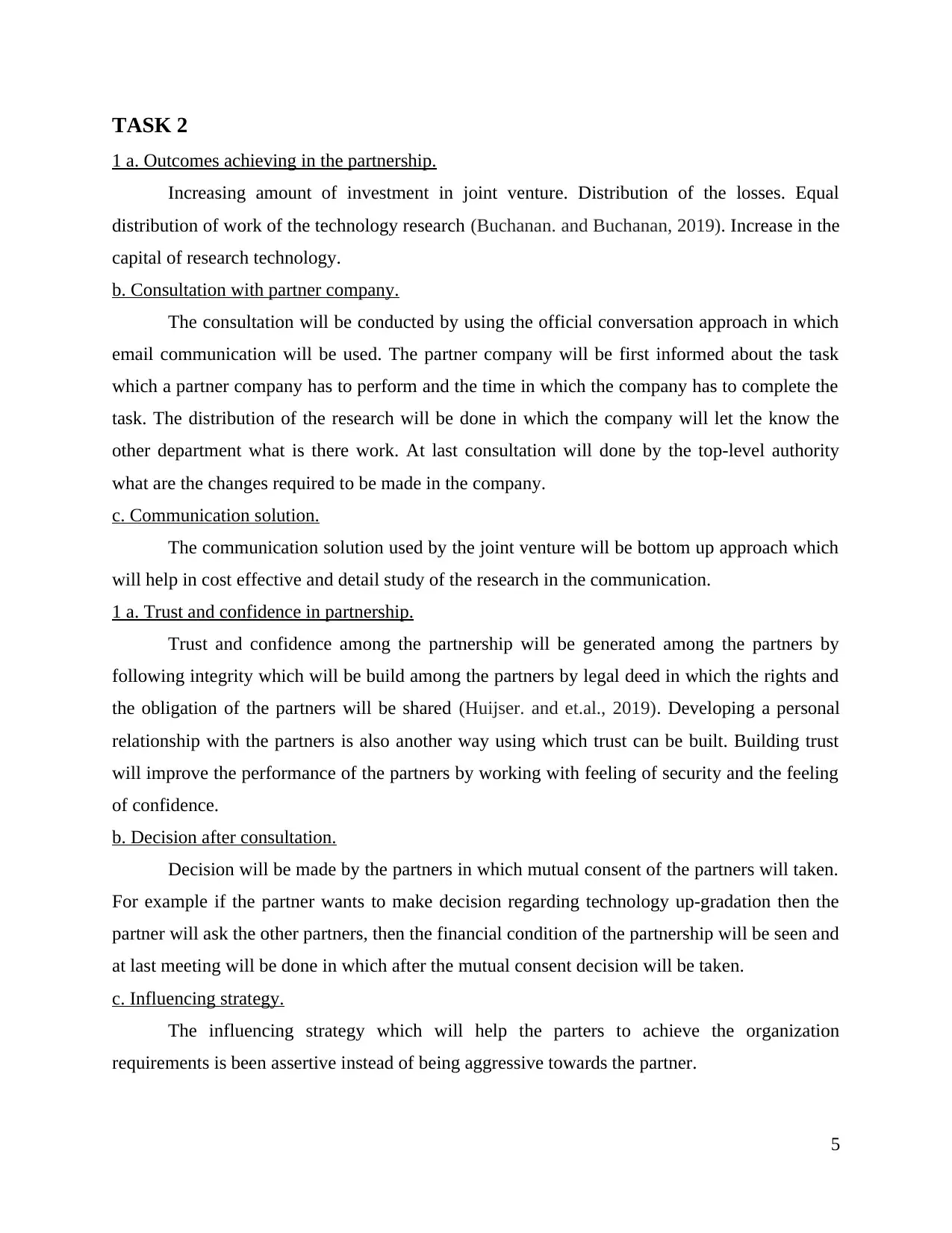
TASK 2
1 a. Outcomes achieving in the partnership.
Increasing amount of investment in joint venture. Distribution of the losses. Equal
distribution of work of the technology research (Buchanan. and Buchanan, 2019). Increase in the
capital of research technology.
b. Consultation with partner company.
The consultation will be conducted by using the official conversation approach in which
email communication will be used. The partner company will be first informed about the task
which a partner company has to perform and the time in which the company has to complete the
task. The distribution of the research will be done in which the company will let the know the
other department what is there work. At last consultation will done by the top-level authority
what are the changes required to be made in the company.
c. Communication solution.
The communication solution used by the joint venture will be bottom up approach which
will help in cost effective and detail study of the research in the communication.
1 a. Trust and confidence in partnership.
Trust and confidence among the partnership will be generated among the partners by
following integrity which will be build among the partners by legal deed in which the rights and
the obligation of the partners will be shared (Huijser. and et.al., 2019). Developing a personal
relationship with the partners is also another way using which trust can be built. Building trust
will improve the performance of the partners by working with feeling of security and the feeling
of confidence.
b. Decision after consultation.
Decision will be made by the partners in which mutual consent of the partners will taken.
For example if the partner wants to make decision regarding technology up-gradation then the
partner will ask the other partners, then the financial condition of the partnership will be seen and
at last meeting will be done in which after the mutual consent decision will be taken.
c. Influencing strategy.
The influencing strategy which will help the parters to achieve the organization
requirements is been assertive instead of being aggressive towards the partner.
5
1 a. Outcomes achieving in the partnership.
Increasing amount of investment in joint venture. Distribution of the losses. Equal
distribution of work of the technology research (Buchanan. and Buchanan, 2019). Increase in the
capital of research technology.
b. Consultation with partner company.
The consultation will be conducted by using the official conversation approach in which
email communication will be used. The partner company will be first informed about the task
which a partner company has to perform and the time in which the company has to complete the
task. The distribution of the research will be done in which the company will let the know the
other department what is there work. At last consultation will done by the top-level authority
what are the changes required to be made in the company.
c. Communication solution.
The communication solution used by the joint venture will be bottom up approach which
will help in cost effective and detail study of the research in the communication.
1 a. Trust and confidence in partnership.
Trust and confidence among the partnership will be generated among the partners by
following integrity which will be build among the partners by legal deed in which the rights and
the obligation of the partners will be shared (Huijser. and et.al., 2019). Developing a personal
relationship with the partners is also another way using which trust can be built. Building trust
will improve the performance of the partners by working with feeling of security and the feeling
of confidence.
b. Decision after consultation.
Decision will be made by the partners in which mutual consent of the partners will taken.
For example if the partner wants to make decision regarding technology up-gradation then the
partner will ask the other partners, then the financial condition of the partnership will be seen and
at last meeting will be done in which after the mutual consent decision will be taken.
c. Influencing strategy.
The influencing strategy which will help the parters to achieve the organization
requirements is been assertive instead of being aggressive towards the partner.
5
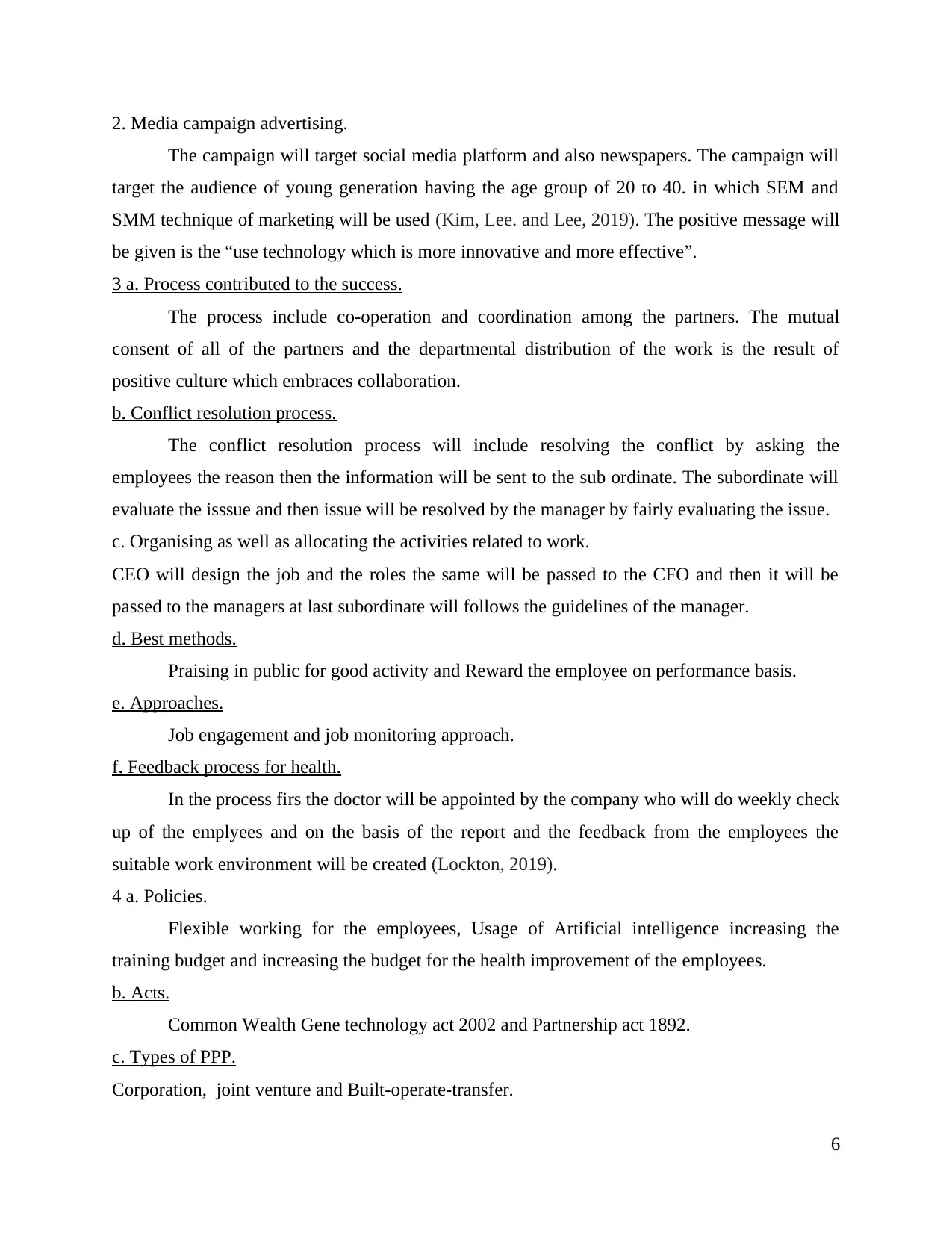
2. Media campaign advertising.
The campaign will target social media platform and also newspapers. The campaign will
target the audience of young generation having the age group of 20 to 40. in which SEM and
SMM technique of marketing will be used (Kim, Lee. and Lee, 2019). The positive message will
be given is the “use technology which is more innovative and more effective”.
3 a. Process contributed to the success.
The process include co-operation and coordination among the partners. The mutual
consent of all of the partners and the departmental distribution of the work is the result of
positive culture which embraces collaboration.
b. Conflict resolution process.
The conflict resolution process will include resolving the conflict by asking the
employees the reason then the information will be sent to the sub ordinate. The subordinate will
evaluate the isssue and then issue will be resolved by the manager by fairly evaluating the issue.
c. Organising as well as allocating the activities related to work.
CEO will design the job and the roles the same will be passed to the CFO and then it will be
passed to the managers at last subordinate will follows the guidelines of the manager.
d. Best methods.
Praising in public for good activity and Reward the employee on performance basis.
e. Approaches.
Job engagement and job monitoring approach.
f. Feedback process for health.
In the process firs the doctor will be appointed by the company who will do weekly check
up of the emplyees and on the basis of the report and the feedback from the employees the
suitable work environment will be created (Lockton, 2019).
4 a. Policies.
Flexible working for the employees, Usage of Artificial intelligence increasing the
training budget and increasing the budget for the health improvement of the employees.
b. Acts.
Common Wealth Gene technology act 2002 and Partnership act 1892.
c. Types of PPP.
Corporation, joint venture and Built-operate-transfer.
6
The campaign will target social media platform and also newspapers. The campaign will
target the audience of young generation having the age group of 20 to 40. in which SEM and
SMM technique of marketing will be used (Kim, Lee. and Lee, 2019). The positive message will
be given is the “use technology which is more innovative and more effective”.
3 a. Process contributed to the success.
The process include co-operation and coordination among the partners. The mutual
consent of all of the partners and the departmental distribution of the work is the result of
positive culture which embraces collaboration.
b. Conflict resolution process.
The conflict resolution process will include resolving the conflict by asking the
employees the reason then the information will be sent to the sub ordinate. The subordinate will
evaluate the isssue and then issue will be resolved by the manager by fairly evaluating the issue.
c. Organising as well as allocating the activities related to work.
CEO will design the job and the roles the same will be passed to the CFO and then it will be
passed to the managers at last subordinate will follows the guidelines of the manager.
d. Best methods.
Praising in public for good activity and Reward the employee on performance basis.
e. Approaches.
Job engagement and job monitoring approach.
f. Feedback process for health.
In the process firs the doctor will be appointed by the company who will do weekly check
up of the emplyees and on the basis of the report and the feedback from the employees the
suitable work environment will be created (Lockton, 2019).
4 a. Policies.
Flexible working for the employees, Usage of Artificial intelligence increasing the
training budget and increasing the budget for the health improvement of the employees.
b. Acts.
Common Wealth Gene technology act 2002 and Partnership act 1892.
c. Types of PPP.
Corporation, joint venture and Built-operate-transfer.
6
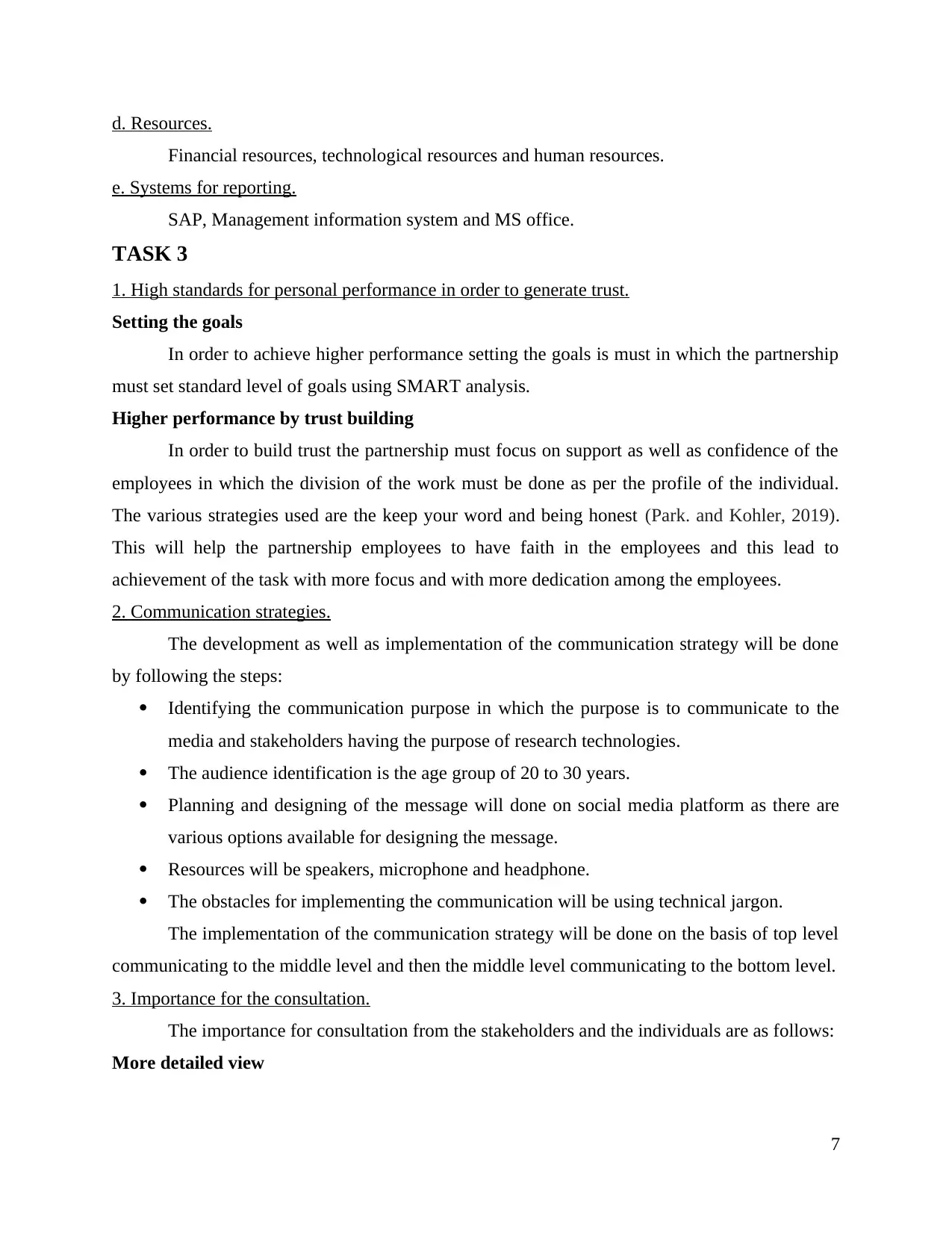
d. Resources.
Financial resources, technological resources and human resources.
e. Systems for reporting.
SAP, Management information system and MS office.
TASK 3
1. High standards for personal performance in order to generate trust.
Setting the goals
In order to achieve higher performance setting the goals is must in which the partnership
must set standard level of goals using SMART analysis.
Higher performance by trust building
In order to build trust the partnership must focus on support as well as confidence of the
employees in which the division of the work must be done as per the profile of the individual.
The various strategies used are the keep your word and being honest (Park. and Kohler, 2019).
This will help the partnership employees to have faith in the employees and this lead to
achievement of the task with more focus and with more dedication among the employees.
2. Communication strategies.
The development as well as implementation of the communication strategy will be done
by following the steps:
Identifying the communication purpose in which the purpose is to communicate to the
media and stakeholders having the purpose of research technologies.
The audience identification is the age group of 20 to 30 years.
Planning and designing of the message will done on social media platform as there are
various options available for designing the message.
Resources will be speakers, microphone and headphone.
The obstacles for implementing the communication will be using technical jargon.
The implementation of the communication strategy will be done on the basis of top level
communicating to the middle level and then the middle level communicating to the bottom level.
3. Importance for the consultation.
The importance for consultation from the stakeholders and the individuals are as follows:
More detailed view
7
Financial resources, technological resources and human resources.
e. Systems for reporting.
SAP, Management information system and MS office.
TASK 3
1. High standards for personal performance in order to generate trust.
Setting the goals
In order to achieve higher performance setting the goals is must in which the partnership
must set standard level of goals using SMART analysis.
Higher performance by trust building
In order to build trust the partnership must focus on support as well as confidence of the
employees in which the division of the work must be done as per the profile of the individual.
The various strategies used are the keep your word and being honest (Park. and Kohler, 2019).
This will help the partnership employees to have faith in the employees and this lead to
achievement of the task with more focus and with more dedication among the employees.
2. Communication strategies.
The development as well as implementation of the communication strategy will be done
by following the steps:
Identifying the communication purpose in which the purpose is to communicate to the
media and stakeholders having the purpose of research technologies.
The audience identification is the age group of 20 to 30 years.
Planning and designing of the message will done on social media platform as there are
various options available for designing the message.
Resources will be speakers, microphone and headphone.
The obstacles for implementing the communication will be using technical jargon.
The implementation of the communication strategy will be done on the basis of top level
communicating to the middle level and then the middle level communicating to the bottom level.
3. Importance for the consultation.
The importance for consultation from the stakeholders and the individuals are as follows:
More detailed view
7
Secure Best Marks with AI Grader
Need help grading? Try our AI Grader for instant feedback on your assignments.
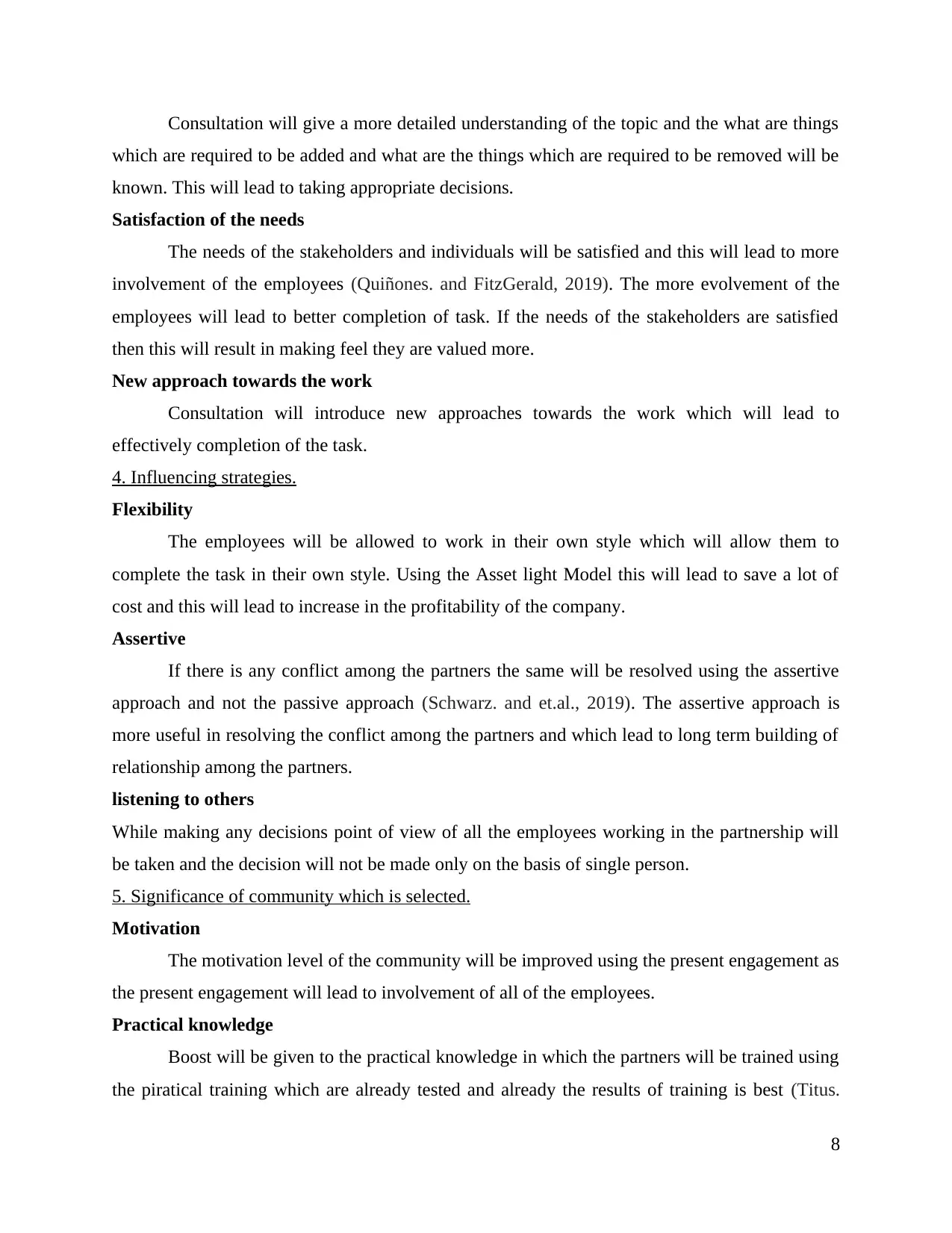
Consultation will give a more detailed understanding of the topic and the what are things
which are required to be added and what are the things which are required to be removed will be
known. This will lead to taking appropriate decisions.
Satisfaction of the needs
The needs of the stakeholders and individuals will be satisfied and this will lead to more
involvement of the employees (Quiñones. and FitzGerald, 2019). The more evolvement of the
employees will lead to better completion of task. If the needs of the stakeholders are satisfied
then this will result in making feel they are valued more.
New approach towards the work
Consultation will introduce new approaches towards the work which will lead to
effectively completion of the task.
4. Influencing strategies.
Flexibility
The employees will be allowed to work in their own style which will allow them to
complete the task in their own style. Using the Asset light Model this will lead to save a lot of
cost and this will lead to increase in the profitability of the company.
Assertive
If there is any conflict among the partners the same will be resolved using the assertive
approach and not the passive approach (Schwarz. and et.al., 2019). The assertive approach is
more useful in resolving the conflict among the partners and which lead to long term building of
relationship among the partners.
listening to others
While making any decisions point of view of all the employees working in the partnership will
be taken and the decision will not be made only on the basis of single person.
5. Significance of community which is selected.
Motivation
The motivation level of the community will be improved using the present engagement as
the present engagement will lead to involvement of all of the employees.
Practical knowledge
Boost will be given to the practical knowledge in which the partners will be trained using
the piratical training which are already tested and already the results of training is best (Titus.
8
which are required to be added and what are the things which are required to be removed will be
known. This will lead to taking appropriate decisions.
Satisfaction of the needs
The needs of the stakeholders and individuals will be satisfied and this will lead to more
involvement of the employees (Quiñones. and FitzGerald, 2019). The more evolvement of the
employees will lead to better completion of task. If the needs of the stakeholders are satisfied
then this will result in making feel they are valued more.
New approach towards the work
Consultation will introduce new approaches towards the work which will lead to
effectively completion of the task.
4. Influencing strategies.
Flexibility
The employees will be allowed to work in their own style which will allow them to
complete the task in their own style. Using the Asset light Model this will lead to save a lot of
cost and this will lead to increase in the profitability of the company.
Assertive
If there is any conflict among the partners the same will be resolved using the assertive
approach and not the passive approach (Schwarz. and et.al., 2019). The assertive approach is
more useful in resolving the conflict among the partners and which lead to long term building of
relationship among the partners.
listening to others
While making any decisions point of view of all the employees working in the partnership will
be taken and the decision will not be made only on the basis of single person.
5. Significance of community which is selected.
Motivation
The motivation level of the community will be improved using the present engagement as
the present engagement will lead to involvement of all of the employees.
Practical knowledge
Boost will be given to the practical knowledge in which the partners will be trained using
the piratical training which are already tested and already the results of training is best (Titus.
8
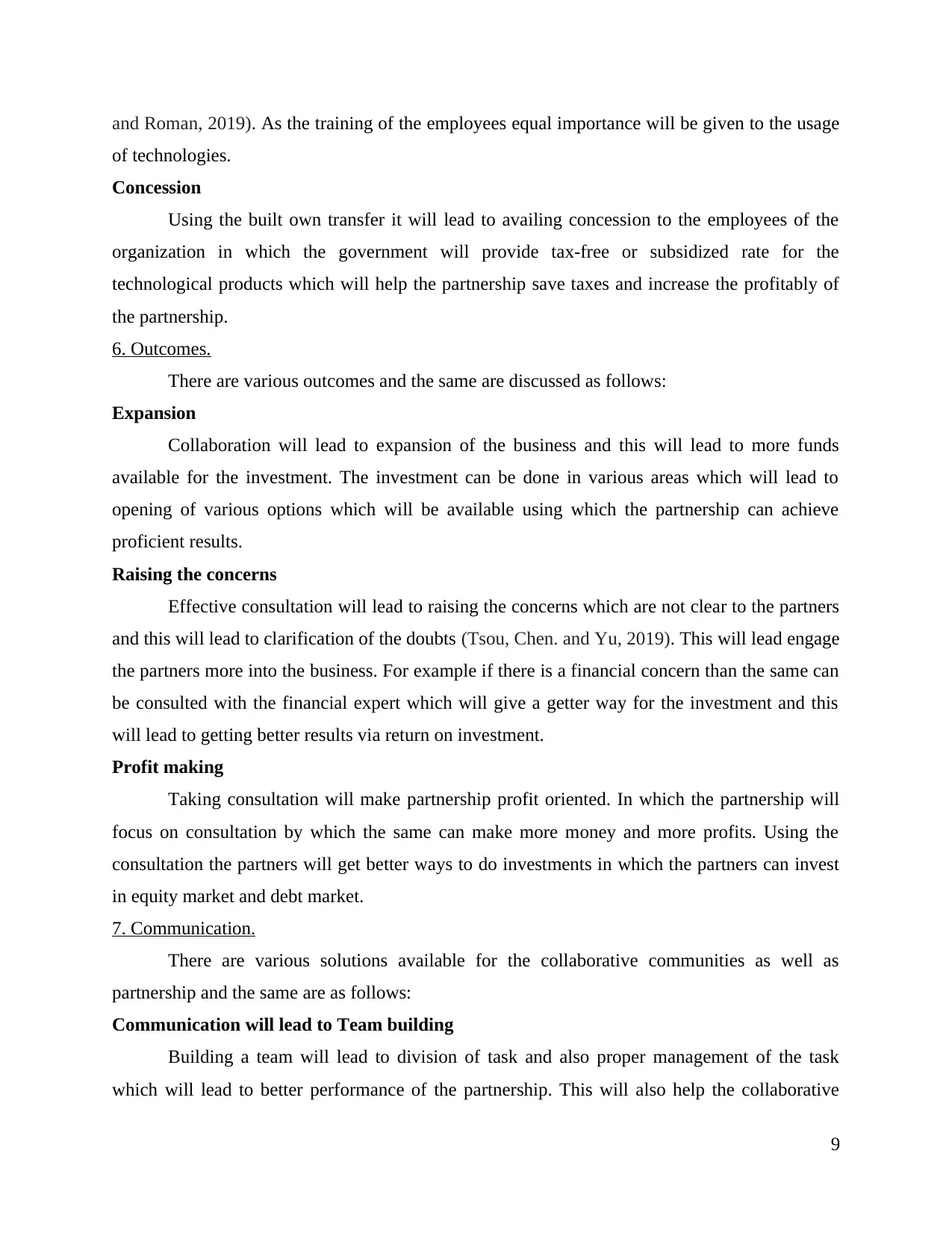
and Roman, 2019). As the training of the employees equal importance will be given to the usage
of technologies.
Concession
Using the built own transfer it will lead to availing concession to the employees of the
organization in which the government will provide tax-free or subsidized rate for the
technological products which will help the partnership save taxes and increase the profitably of
the partnership.
6. Outcomes.
There are various outcomes and the same are discussed as follows:
Expansion
Collaboration will lead to expansion of the business and this will lead to more funds
available for the investment. The investment can be done in various areas which will lead to
opening of various options which will be available using which the partnership can achieve
proficient results.
Raising the concerns
Effective consultation will lead to raising the concerns which are not clear to the partners
and this will lead to clarification of the doubts (Tsou, Chen. and Yu, 2019). This will lead engage
the partners more into the business. For example if there is a financial concern than the same can
be consulted with the financial expert which will give a getter way for the investment and this
will lead to getting better results via return on investment.
Profit making
Taking consultation will make partnership profit oriented. In which the partnership will
focus on consultation by which the same can make more money and more profits. Using the
consultation the partners will get better ways to do investments in which the partners can invest
in equity market and debt market.
7. Communication.
There are various solutions available for the collaborative communities as well as
partnership and the same are as follows:
Communication will lead to Team building
Building a team will lead to division of task and also proper management of the task
which will lead to better performance of the partnership. This will also help the collaborative
9
of technologies.
Concession
Using the built own transfer it will lead to availing concession to the employees of the
organization in which the government will provide tax-free or subsidized rate for the
technological products which will help the partnership save taxes and increase the profitably of
the partnership.
6. Outcomes.
There are various outcomes and the same are discussed as follows:
Expansion
Collaboration will lead to expansion of the business and this will lead to more funds
available for the investment. The investment can be done in various areas which will lead to
opening of various options which will be available using which the partnership can achieve
proficient results.
Raising the concerns
Effective consultation will lead to raising the concerns which are not clear to the partners
and this will lead to clarification of the doubts (Tsou, Chen. and Yu, 2019). This will lead engage
the partners more into the business. For example if there is a financial concern than the same can
be consulted with the financial expert which will give a getter way for the investment and this
will lead to getting better results via return on investment.
Profit making
Taking consultation will make partnership profit oriented. In which the partnership will
focus on consultation by which the same can make more money and more profits. Using the
consultation the partners will get better ways to do investments in which the partners can invest
in equity market and debt market.
7. Communication.
There are various solutions available for the collaborative communities as well as
partnership and the same are as follows:
Communication will lead to Team building
Building a team will lead to division of task and also proper management of the task
which will lead to better performance of the partnership. This will also help the collaborative
9
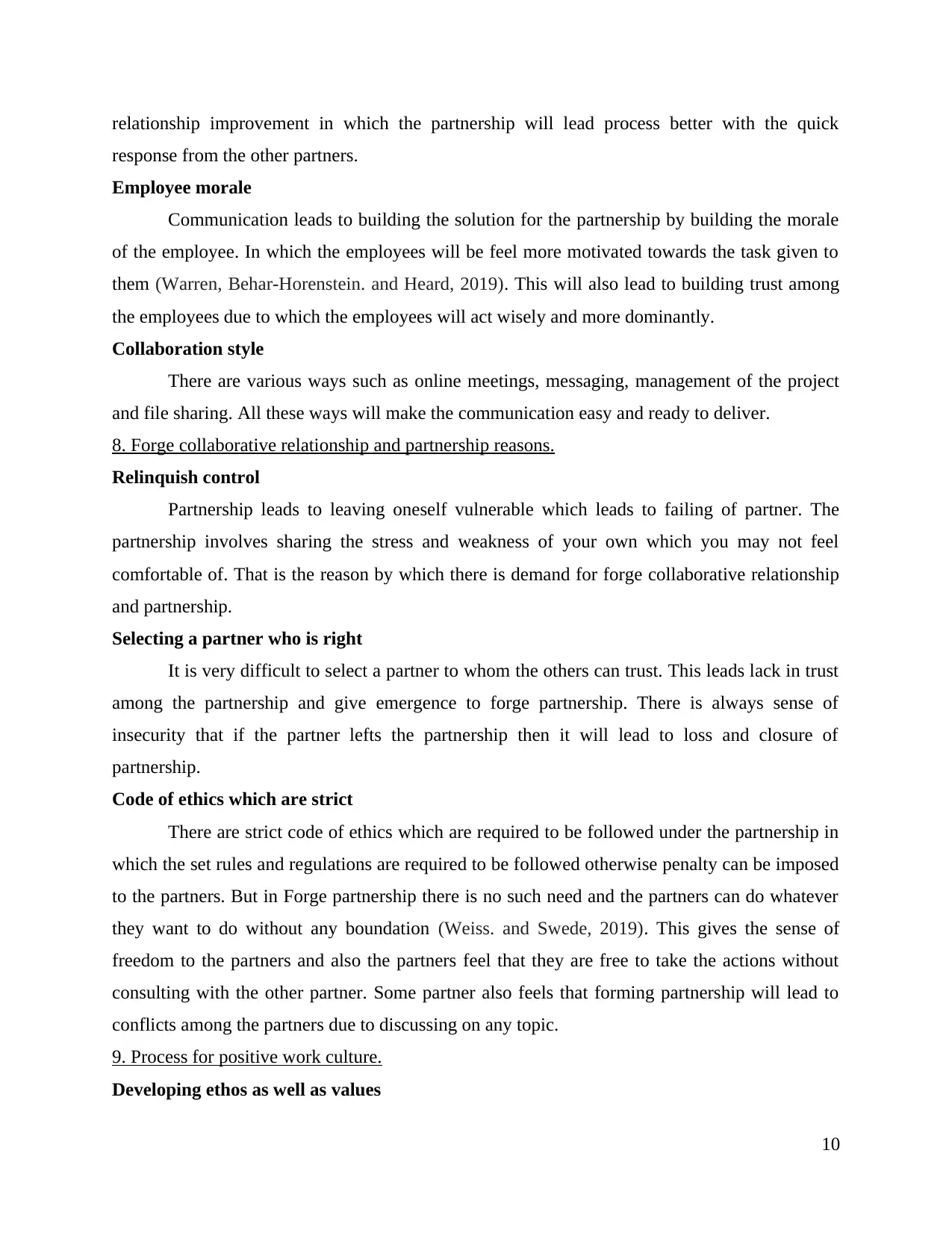
relationship improvement in which the partnership will lead process better with the quick
response from the other partners.
Employee morale
Communication leads to building the solution for the partnership by building the morale
of the employee. In which the employees will be feel more motivated towards the task given to
them (Warren, Behar-Horenstein. and Heard, 2019). This will also lead to building trust among
the employees due to which the employees will act wisely and more dominantly.
Collaboration style
There are various ways such as online meetings, messaging, management of the project
and file sharing. All these ways will make the communication easy and ready to deliver.
8. Forge collaborative relationship and partnership reasons.
Relinquish control
Partnership leads to leaving oneself vulnerable which leads to failing of partner. The
partnership involves sharing the stress and weakness of your own which you may not feel
comfortable of. That is the reason by which there is demand for forge collaborative relationship
and partnership.
Selecting a partner who is right
It is very difficult to select a partner to whom the others can trust. This leads lack in trust
among the partnership and give emergence to forge partnership. There is always sense of
insecurity that if the partner lefts the partnership then it will lead to loss and closure of
partnership.
Code of ethics which are strict
There are strict code of ethics which are required to be followed under the partnership in
which the set rules and regulations are required to be followed otherwise penalty can be imposed
to the partners. But in Forge partnership there is no such need and the partners can do whatever
they want to do without any boundation (Weiss. and Swede, 2019). This gives the sense of
freedom to the partners and also the partners feel that they are free to take the actions without
consulting with the other partner. Some partner also feels that forming partnership will lead to
conflicts among the partners due to discussing on any topic.
9. Process for positive work culture.
Developing ethos as well as values
10
response from the other partners.
Employee morale
Communication leads to building the solution for the partnership by building the morale
of the employee. In which the employees will be feel more motivated towards the task given to
them (Warren, Behar-Horenstein. and Heard, 2019). This will also lead to building trust among
the employees due to which the employees will act wisely and more dominantly.
Collaboration style
There are various ways such as online meetings, messaging, management of the project
and file sharing. All these ways will make the communication easy and ready to deliver.
8. Forge collaborative relationship and partnership reasons.
Relinquish control
Partnership leads to leaving oneself vulnerable which leads to failing of partner. The
partnership involves sharing the stress and weakness of your own which you may not feel
comfortable of. That is the reason by which there is demand for forge collaborative relationship
and partnership.
Selecting a partner who is right
It is very difficult to select a partner to whom the others can trust. This leads lack in trust
among the partnership and give emergence to forge partnership. There is always sense of
insecurity that if the partner lefts the partnership then it will lead to loss and closure of
partnership.
Code of ethics which are strict
There are strict code of ethics which are required to be followed under the partnership in
which the set rules and regulations are required to be followed otherwise penalty can be imposed
to the partners. But in Forge partnership there is no such need and the partners can do whatever
they want to do without any boundation (Weiss. and Swede, 2019). This gives the sense of
freedom to the partners and also the partners feel that they are free to take the actions without
consulting with the other partner. Some partner also feels that forming partnership will lead to
conflicts among the partners due to discussing on any topic.
9. Process for positive work culture.
Developing ethos as well as values
10
Paraphrase This Document
Need a fresh take? Get an instant paraphrase of this document with our AI Paraphraser
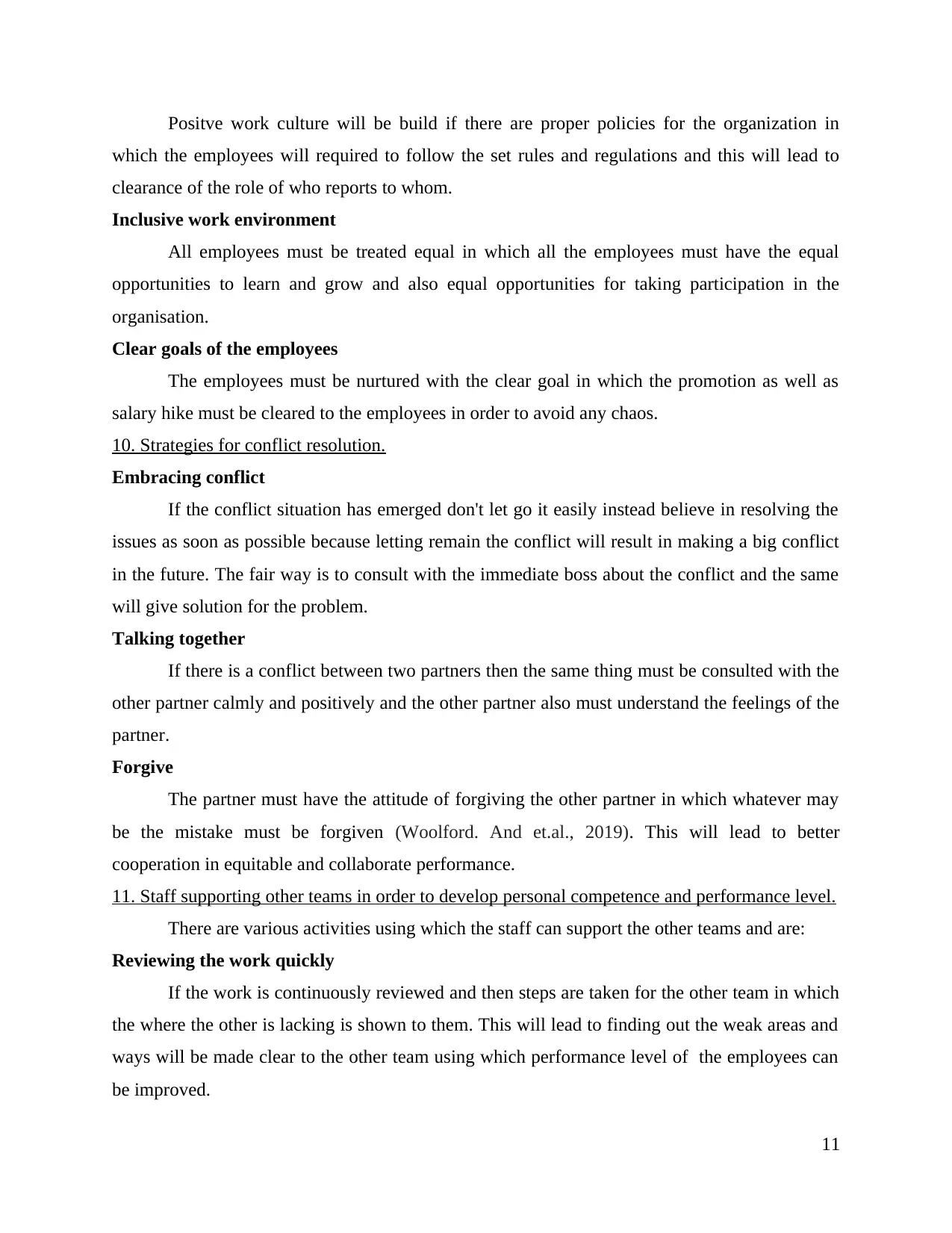
Positve work culture will be build if there are proper policies for the organization in
which the employees will required to follow the set rules and regulations and this will lead to
clearance of the role of who reports to whom.
Inclusive work environment
All employees must be treated equal in which all the employees must have the equal
opportunities to learn and grow and also equal opportunities for taking participation in the
organisation.
Clear goals of the employees
The employees must be nurtured with the clear goal in which the promotion as well as
salary hike must be cleared to the employees in order to avoid any chaos.
10. Strategies for conflict resolution.
Embracing conflict
If the conflict situation has emerged don't let go it easily instead believe in resolving the
issues as soon as possible because letting remain the conflict will result in making a big conflict
in the future. The fair way is to consult with the immediate boss about the conflict and the same
will give solution for the problem.
Talking together
If there is a conflict between two partners then the same thing must be consulted with the
other partner calmly and positively and the other partner also must understand the feelings of the
partner.
Forgive
The partner must have the attitude of forgiving the other partner in which whatever may
be the mistake must be forgiven (Woolford. And et.al., 2019). This will lead to better
cooperation in equitable and collaborate performance.
11. Staff supporting other teams in order to develop personal competence and performance level.
There are various activities using which the staff can support the other teams and are:
Reviewing the work quickly
If the work is continuously reviewed and then steps are taken for the other team in which
the where the other is lacking is shown to them. This will lead to finding out the weak areas and
ways will be made clear to the other team using which performance level of the employees can
be improved.
11
which the employees will required to follow the set rules and regulations and this will lead to
clearance of the role of who reports to whom.
Inclusive work environment
All employees must be treated equal in which all the employees must have the equal
opportunities to learn and grow and also equal opportunities for taking participation in the
organisation.
Clear goals of the employees
The employees must be nurtured with the clear goal in which the promotion as well as
salary hike must be cleared to the employees in order to avoid any chaos.
10. Strategies for conflict resolution.
Embracing conflict
If the conflict situation has emerged don't let go it easily instead believe in resolving the
issues as soon as possible because letting remain the conflict will result in making a big conflict
in the future. The fair way is to consult with the immediate boss about the conflict and the same
will give solution for the problem.
Talking together
If there is a conflict between two partners then the same thing must be consulted with the
other partner calmly and positively and the other partner also must understand the feelings of the
partner.
Forgive
The partner must have the attitude of forgiving the other partner in which whatever may
be the mistake must be forgiven (Woolford. And et.al., 2019). This will lead to better
cooperation in equitable and collaborate performance.
11. Staff supporting other teams in order to develop personal competence and performance level.
There are various activities using which the staff can support the other teams and are:
Reviewing the work quickly
If the work is continuously reviewed and then steps are taken for the other team in which
the where the other is lacking is shown to them. This will lead to finding out the weak areas and
ways will be made clear to the other team using which performance level of the employees can
be improved.
11
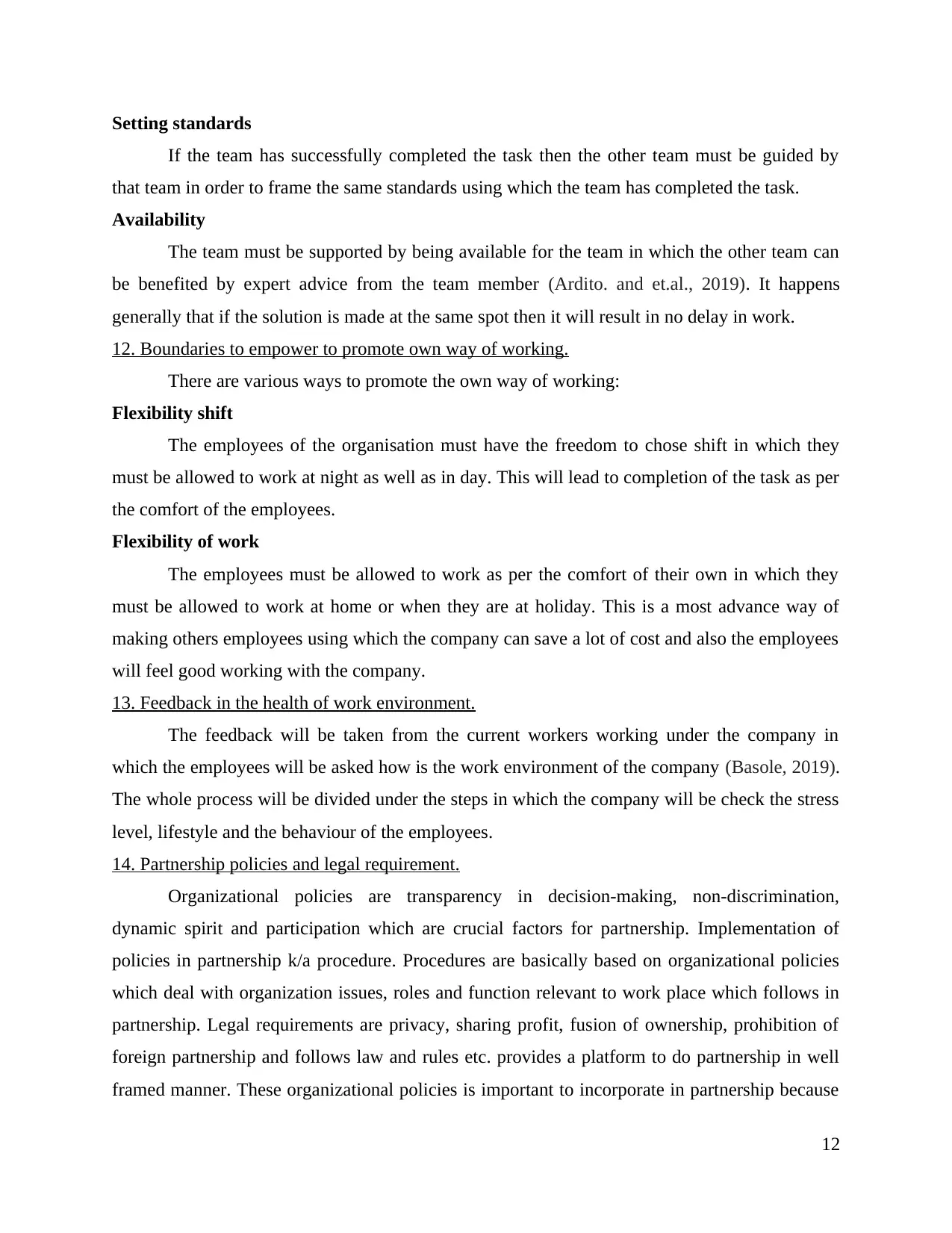
Setting standards
If the team has successfully completed the task then the other team must be guided by
that team in order to frame the same standards using which the team has completed the task.
Availability
The team must be supported by being available for the team in which the other team can
be benefited by expert advice from the team member (Ardito. and et.al., 2019). It happens
generally that if the solution is made at the same spot then it will result in no delay in work.
12. Boundaries to empower to promote own way of working.
There are various ways to promote the own way of working:
Flexibility shift
The employees of the organisation must have the freedom to chose shift in which they
must be allowed to work at night as well as in day. This will lead to completion of the task as per
the comfort of the employees.
Flexibility of work
The employees must be allowed to work as per the comfort of their own in which they
must be allowed to work at home or when they are at holiday. This is a most advance way of
making others employees using which the company can save a lot of cost and also the employees
will feel good working with the company.
13. Feedback in the health of work environment.
The feedback will be taken from the current workers working under the company in
which the employees will be asked how is the work environment of the company (Basole, 2019).
The whole process will be divided under the steps in which the company will be check the stress
level, lifestyle and the behaviour of the employees.
14. Partnership policies and legal requirement.
Organizational policies are transparency in decision-making, non-discrimination,
dynamic spirit and participation which are crucial factors for partnership. Implementation of
policies in partnership k/a procedure. Procedures are basically based on organizational policies
which deal with organization issues, roles and function relevant to work place which follows in
partnership. Legal requirements are privacy, sharing profit, fusion of ownership, prohibition of
foreign partnership and follows law and rules etc. provides a platform to do partnership in well
framed manner. These organizational policies is important to incorporate in partnership because
12
If the team has successfully completed the task then the other team must be guided by
that team in order to frame the same standards using which the team has completed the task.
Availability
The team must be supported by being available for the team in which the other team can
be benefited by expert advice from the team member (Ardito. and et.al., 2019). It happens
generally that if the solution is made at the same spot then it will result in no delay in work.
12. Boundaries to empower to promote own way of working.
There are various ways to promote the own way of working:
Flexibility shift
The employees of the organisation must have the freedom to chose shift in which they
must be allowed to work at night as well as in day. This will lead to completion of the task as per
the comfort of the employees.
Flexibility of work
The employees must be allowed to work as per the comfort of their own in which they
must be allowed to work at home or when they are at holiday. This is a most advance way of
making others employees using which the company can save a lot of cost and also the employees
will feel good working with the company.
13. Feedback in the health of work environment.
The feedback will be taken from the current workers working under the company in
which the employees will be asked how is the work environment of the company (Basole, 2019).
The whole process will be divided under the steps in which the company will be check the stress
level, lifestyle and the behaviour of the employees.
14. Partnership policies and legal requirement.
Organizational policies are transparency in decision-making, non-discrimination,
dynamic spirit and participation which are crucial factors for partnership. Implementation of
policies in partnership k/a procedure. Procedures are basically based on organizational policies
which deal with organization issues, roles and function relevant to work place which follows in
partnership. Legal requirements are privacy, sharing profit, fusion of ownership, prohibition of
foreign partnership and follows law and rules etc. provides a platform to do partnership in well
framed manner. These organizational policies is important to incorporate in partnership because
12
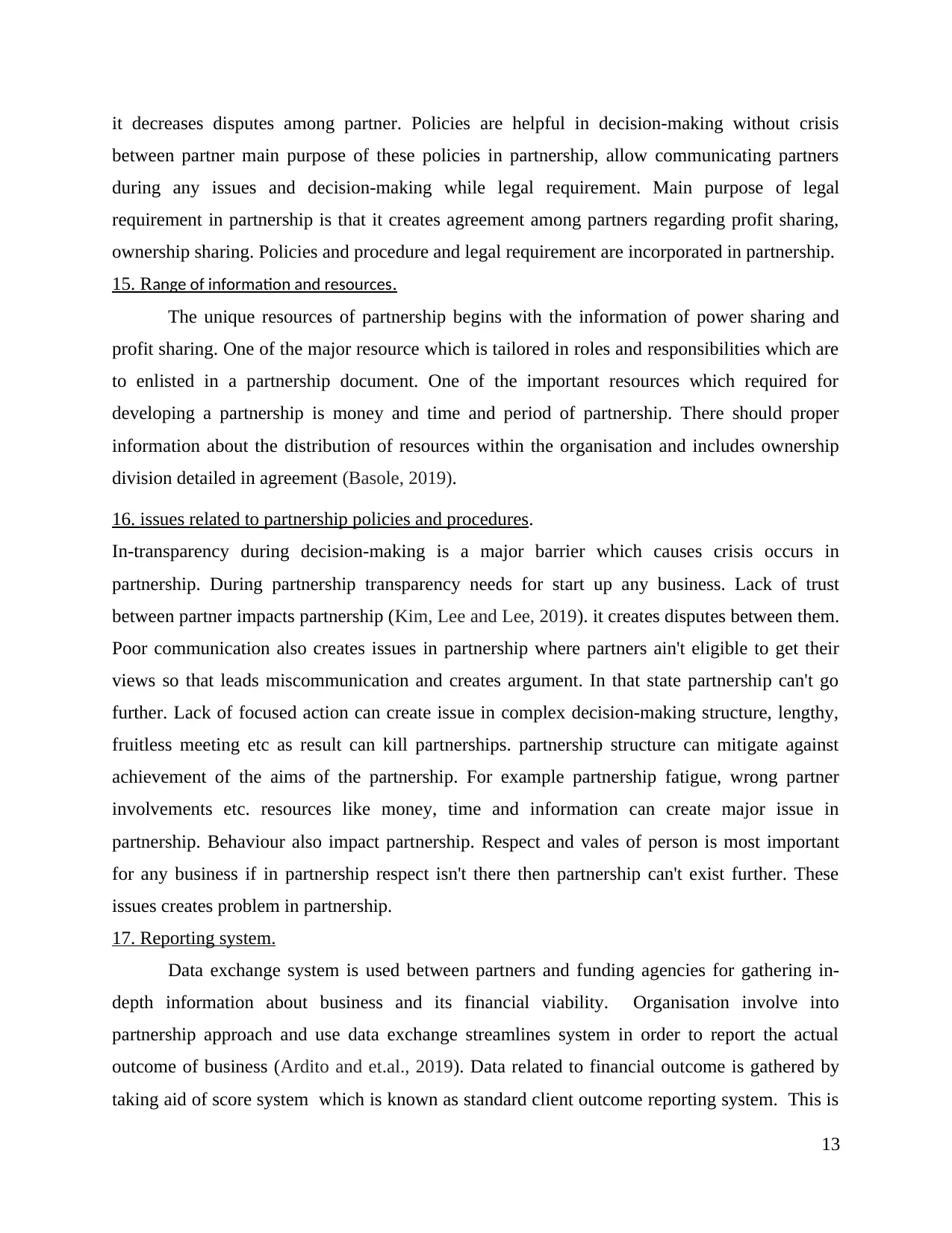
it decreases disputes among partner. Policies are helpful in decision-making without crisis
between partner main purpose of these policies in partnership, allow communicating partners
during any issues and decision-making while legal requirement. Main purpose of legal
requirement in partnership is that it creates agreement among partners regarding profit sharing,
ownership sharing. Policies and procedure and legal requirement are incorporated in partnership.
15. Range of information and resources.
The unique resources of partnership begins with the information of power sharing and
profit sharing. One of the major resource which is tailored in roles and responsibilities which are
to enlisted in a partnership document. One of the important resources which required for
developing a partnership is money and time and period of partnership. There should proper
information about the distribution of resources within the organisation and includes ownership
division detailed in agreement (Basole, 2019).
16. issues related to partnership policies and procedures.
In-transparency during decision-making is a major barrier which causes crisis occurs in
partnership. During partnership transparency needs for start up any business. Lack of trust
between partner impacts partnership (Kim, Lee and Lee, 2019). it creates disputes between them.
Poor communication also creates issues in partnership where partners ain't eligible to get their
views so that leads miscommunication and creates argument. In that state partnership can't go
further. Lack of focused action can create issue in complex decision-making structure, lengthy,
fruitless meeting etc as result can kill partnerships. partnership structure can mitigate against
achievement of the aims of the partnership. For example partnership fatigue, wrong partner
involvements etc. resources like money, time and information can create major issue in
partnership. Behaviour also impact partnership. Respect and vales of person is most important
for any business if in partnership respect isn't there then partnership can't exist further. These
issues creates problem in partnership.
17. Reporting system.
Data exchange system is used between partners and funding agencies for gathering in-
depth information about business and its financial viability. Organisation involve into
partnership approach and use data exchange streamlines system in order to report the actual
outcome of business (Ardito and et.al., 2019). Data related to financial outcome is gathered by
taking aid of score system which is known as standard client outcome reporting system. This is
13
between partner main purpose of these policies in partnership, allow communicating partners
during any issues and decision-making while legal requirement. Main purpose of legal
requirement in partnership is that it creates agreement among partners regarding profit sharing,
ownership sharing. Policies and procedure and legal requirement are incorporated in partnership.
15. Range of information and resources.
The unique resources of partnership begins with the information of power sharing and
profit sharing. One of the major resource which is tailored in roles and responsibilities which are
to enlisted in a partnership document. One of the important resources which required for
developing a partnership is money and time and period of partnership. There should proper
information about the distribution of resources within the organisation and includes ownership
division detailed in agreement (Basole, 2019).
16. issues related to partnership policies and procedures.
In-transparency during decision-making is a major barrier which causes crisis occurs in
partnership. During partnership transparency needs for start up any business. Lack of trust
between partner impacts partnership (Kim, Lee and Lee, 2019). it creates disputes between them.
Poor communication also creates issues in partnership where partners ain't eligible to get their
views so that leads miscommunication and creates argument. In that state partnership can't go
further. Lack of focused action can create issue in complex decision-making structure, lengthy,
fruitless meeting etc as result can kill partnerships. partnership structure can mitigate against
achievement of the aims of the partnership. For example partnership fatigue, wrong partner
involvements etc. resources like money, time and information can create major issue in
partnership. Behaviour also impact partnership. Respect and vales of person is most important
for any business if in partnership respect isn't there then partnership can't exist further. These
issues creates problem in partnership.
17. Reporting system.
Data exchange system is used between partners and funding agencies for gathering in-
depth information about business and its financial viability. Organisation involve into
partnership approach and use data exchange streamlines system in order to report the actual
outcome of business (Ardito and et.al., 2019). Data related to financial outcome is gathered by
taking aid of score system which is known as standard client outcome reporting system. This is
13
Secure Best Marks with AI Grader
Need help grading? Try our AI Grader for instant feedback on your assignments.
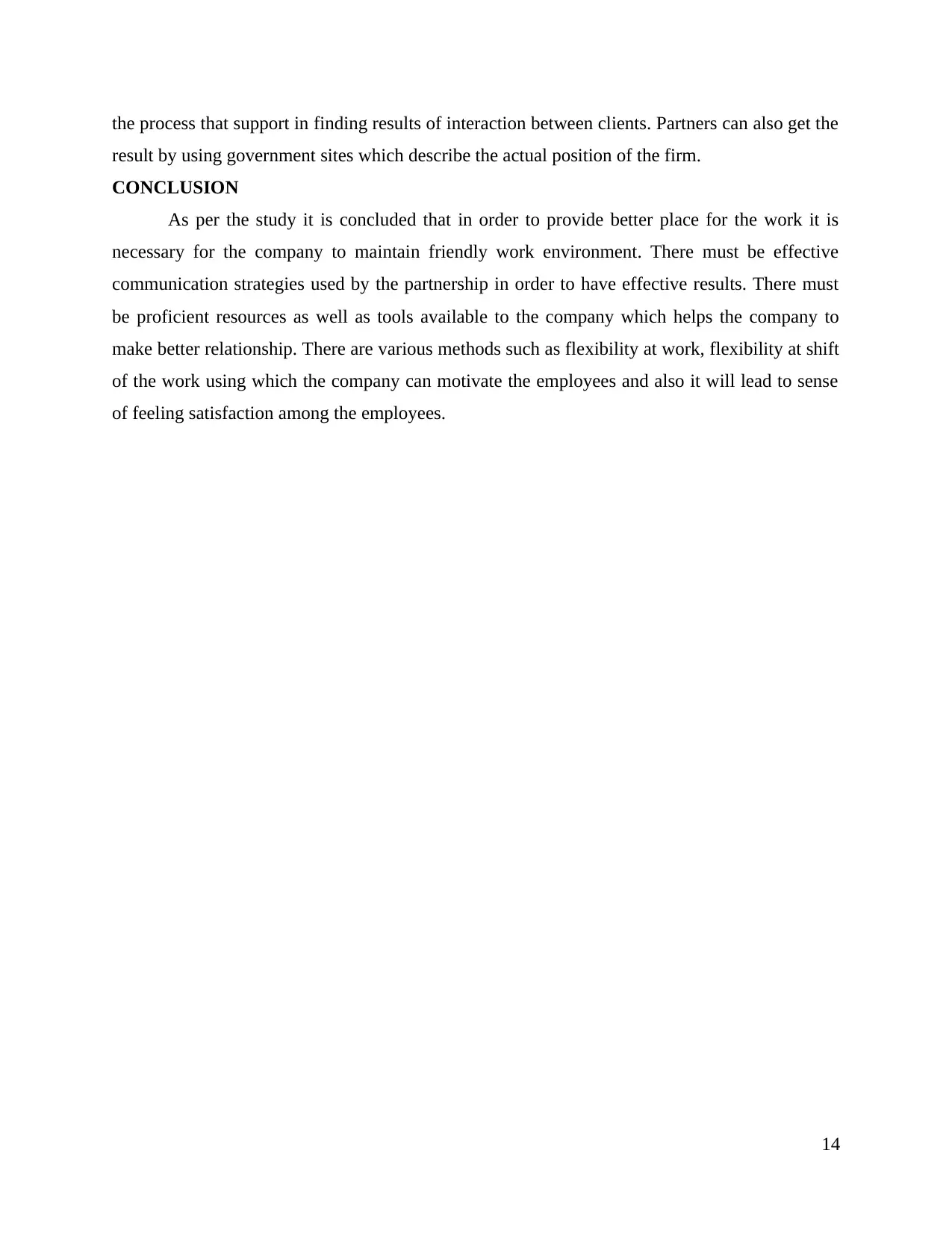
the process that support in finding results of interaction between clients. Partners can also get the
result by using government sites which describe the actual position of the firm.
CONCLUSION
As per the study it is concluded that in order to provide better place for the work it is
necessary for the company to maintain friendly work environment. There must be effective
communication strategies used by the partnership in order to have effective results. There must
be proficient resources as well as tools available to the company which helps the company to
make better relationship. There are various methods such as flexibility at work, flexibility at shift
of the work using which the company can motivate the employees and also it will lead to sense
of feeling satisfaction among the employees.
14
result by using government sites which describe the actual position of the firm.
CONCLUSION
As per the study it is concluded that in order to provide better place for the work it is
necessary for the company to maintain friendly work environment. There must be effective
communication strategies used by the partnership in order to have effective results. There must
be proficient resources as well as tools available to the company which helps the company to
make better relationship. There are various methods such as flexibility at work, flexibility at shift
of the work using which the company can motivate the employees and also it will lead to sense
of feeling satisfaction among the employees.
14
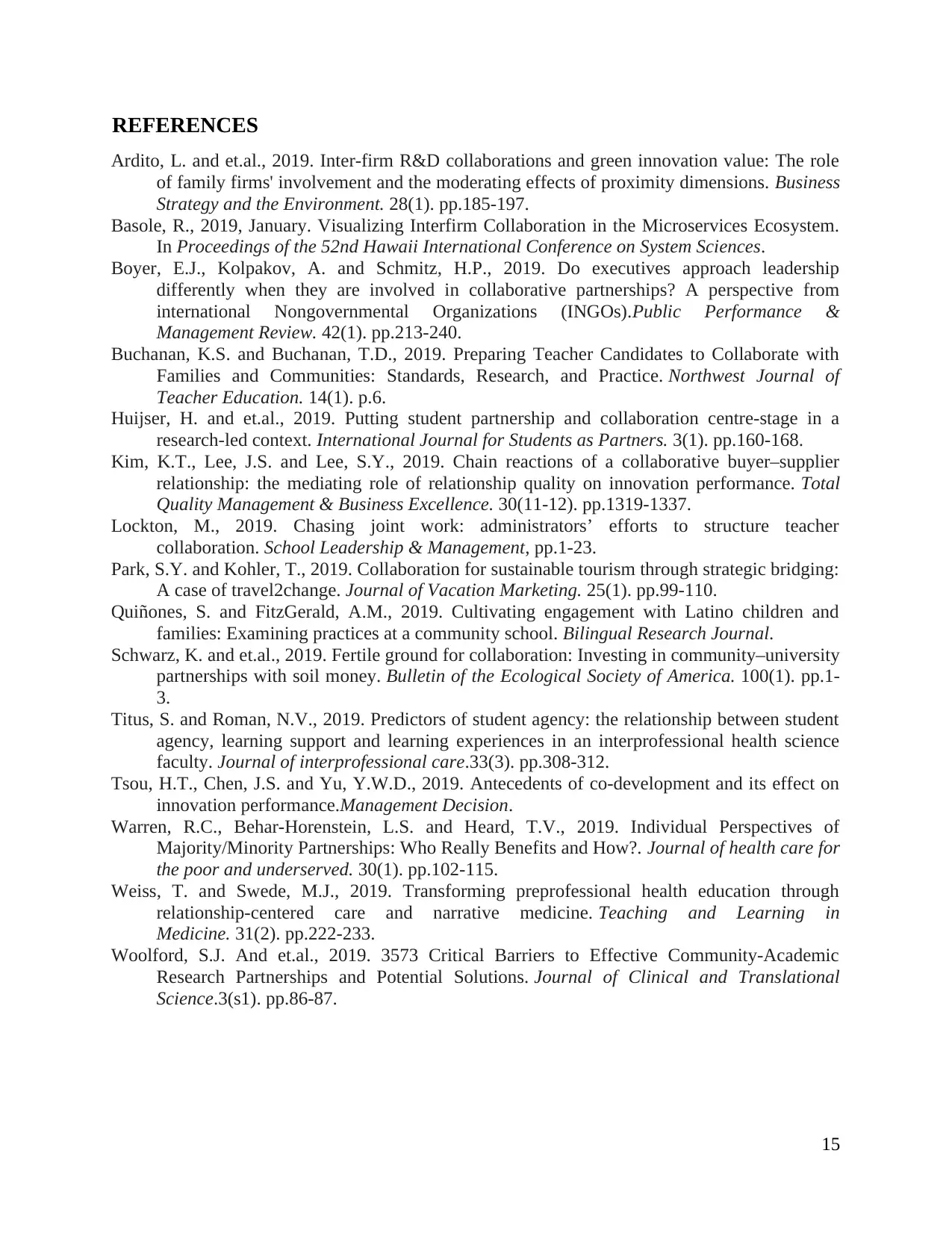
REFERENCES
Ardito, L. and et.al., 2019. Inter‐firm R&D collaborations and green innovation value: The role
of family firms' involvement and the moderating effects of proximity dimensions. Business
Strategy and the Environment. 28(1). pp.185-197.
Basole, R., 2019, January. Visualizing Interfirm Collaboration in the Microservices Ecosystem.
In Proceedings of the 52nd Hawaii International Conference on System Sciences.
Boyer, E.J., Kolpakov, A. and Schmitz, H.P., 2019. Do executives approach leadership
differently when they are involved in collaborative partnerships? A perspective from
international Nongovernmental Organizations (INGOs).Public Performance &
Management Review. 42(1). pp.213-240.
Buchanan, K.S. and Buchanan, T.D., 2019. Preparing Teacher Candidates to Collaborate with
Families and Communities: Standards, Research, and Practice. Northwest Journal of
Teacher Education. 14(1). p.6.
Huijser, H. and et.al., 2019. Putting student partnership and collaboration centre-stage in a
research-led context. International Journal for Students as Partners. 3(1). pp.160-168.
Kim, K.T., Lee, J.S. and Lee, S.Y., 2019. Chain reactions of a collaborative buyer–supplier
relationship: the mediating role of relationship quality on innovation performance. Total
Quality Management & Business Excellence. 30(11-12). pp.1319-1337.
Lockton, M., 2019. Chasing joint work: administrators’ efforts to structure teacher
collaboration. School Leadership & Management, pp.1-23.
Park, S.Y. and Kohler, T., 2019. Collaboration for sustainable tourism through strategic bridging:
A case of travel2change. Journal of Vacation Marketing. 25(1). pp.99-110.
Quiñones, S. and FitzGerald, A.M., 2019. Cultivating engagement with Latino children and
families: Examining practices at a community school. Bilingual Research Journal.
Schwarz, K. and et.al., 2019. Fertile ground for collaboration: Investing in community–university
partnerships with soil money. Bulletin of the Ecological Society of America. 100(1). pp.1-
3.
Titus, S. and Roman, N.V., 2019. Predictors of student agency: the relationship between student
agency, learning support and learning experiences in an interprofessional health science
faculty. Journal of interprofessional care.33(3). pp.308-312.
Tsou, H.T., Chen, J.S. and Yu, Y.W.D., 2019. Antecedents of co-development and its effect on
innovation performance.Management Decision.
Warren, R.C., Behar-Horenstein, L.S. and Heard, T.V., 2019. Individual Perspectives of
Majority/Minority Partnerships: Who Really Benefits and How?. Journal of health care for
the poor and underserved. 30(1). pp.102-115.
Weiss, T. and Swede, M.J., 2019. Transforming preprofessional health education through
relationship-centered care and narrative medicine. Teaching and Learning in
Medicine. 31(2). pp.222-233.
Woolford, S.J. And et.al., 2019. 3573 Critical Barriers to Effective Community-Academic
Research Partnerships and Potential Solutions. Journal of Clinical and Translational
Science.3(s1). pp.86-87.
15
Ardito, L. and et.al., 2019. Inter‐firm R&D collaborations and green innovation value: The role
of family firms' involvement and the moderating effects of proximity dimensions. Business
Strategy and the Environment. 28(1). pp.185-197.
Basole, R., 2019, January. Visualizing Interfirm Collaboration in the Microservices Ecosystem.
In Proceedings of the 52nd Hawaii International Conference on System Sciences.
Boyer, E.J., Kolpakov, A. and Schmitz, H.P., 2019. Do executives approach leadership
differently when they are involved in collaborative partnerships? A perspective from
international Nongovernmental Organizations (INGOs).Public Performance &
Management Review. 42(1). pp.213-240.
Buchanan, K.S. and Buchanan, T.D., 2019. Preparing Teacher Candidates to Collaborate with
Families and Communities: Standards, Research, and Practice. Northwest Journal of
Teacher Education. 14(1). p.6.
Huijser, H. and et.al., 2019. Putting student partnership and collaboration centre-stage in a
research-led context. International Journal for Students as Partners. 3(1). pp.160-168.
Kim, K.T., Lee, J.S. and Lee, S.Y., 2019. Chain reactions of a collaborative buyer–supplier
relationship: the mediating role of relationship quality on innovation performance. Total
Quality Management & Business Excellence. 30(11-12). pp.1319-1337.
Lockton, M., 2019. Chasing joint work: administrators’ efforts to structure teacher
collaboration. School Leadership & Management, pp.1-23.
Park, S.Y. and Kohler, T., 2019. Collaboration for sustainable tourism through strategic bridging:
A case of travel2change. Journal of Vacation Marketing. 25(1). pp.99-110.
Quiñones, S. and FitzGerald, A.M., 2019. Cultivating engagement with Latino children and
families: Examining practices at a community school. Bilingual Research Journal.
Schwarz, K. and et.al., 2019. Fertile ground for collaboration: Investing in community–university
partnerships with soil money. Bulletin of the Ecological Society of America. 100(1). pp.1-
3.
Titus, S. and Roman, N.V., 2019. Predictors of student agency: the relationship between student
agency, learning support and learning experiences in an interprofessional health science
faculty. Journal of interprofessional care.33(3). pp.308-312.
Tsou, H.T., Chen, J.S. and Yu, Y.W.D., 2019. Antecedents of co-development and its effect on
innovation performance.Management Decision.
Warren, R.C., Behar-Horenstein, L.S. and Heard, T.V., 2019. Individual Perspectives of
Majority/Minority Partnerships: Who Really Benefits and How?. Journal of health care for
the poor and underserved. 30(1). pp.102-115.
Weiss, T. and Swede, M.J., 2019. Transforming preprofessional health education through
relationship-centered care and narrative medicine. Teaching and Learning in
Medicine. 31(2). pp.222-233.
Woolford, S.J. And et.al., 2019. 3573 Critical Barriers to Effective Community-Academic
Research Partnerships and Potential Solutions. Journal of Clinical and Translational
Science.3(s1). pp.86-87.
15
1 out of 18
Related Documents
Your All-in-One AI-Powered Toolkit for Academic Success.
+13062052269
info@desklib.com
Available 24*7 on WhatsApp / Email
![[object Object]](/_next/static/media/star-bottom.7253800d.svg)
Unlock your academic potential
© 2024 | Zucol Services PVT LTD | All rights reserved.





